#but this iteration of link has lost so much-even before the game it seems taking his destiny has made him quiet
Text
Visions
#i have so much love for botw link#he remembers nothing but the weight of the sword#he is willing to take in incredible amounts of pain and responsibility just to understand himself and his previous life a bit better#its not as if he’s not responsible and courageous#but this iteration of link has lost so much-even before the game it seems taking his destiny has made him quiet#dunno remember who was it who wrote#‘the sword became a needle snd with the thread of destiny; it sew his lips’#but apart from the desesperation of looking for a trace of himself in all things#he is also guilty and scared of what his past holds#anyways i should write a fanfic not pour this into tags#botw#breath of the wild#link#legend of zelda#master sword#animation#procreate dreams#link botw
5K notes
·
View notes
Note
So far you seem to have a really good grasp on everyone’s character so I just wanted to hear your thoughts on this: when people talk about hero’s reaction to the truth it never feels quite right, like it feels lacking, said thing that’s missing is the fact it was sunny that did it, Mari’s beloved little brother that hero knows loved Mari so much too, I never see people bring up that point which is sad because I think it would create a interesting conflict within hero because on one hand sunny killed Mari on the other hand it was an accident and after cooling down a little he realizes that Mari would probably want him to not hurt sunny over it plus even though sunny killed her he’s also the last piece of her left (on a different note my hc is that hero sees sunny as a brother in law even though he never got the chance to marry Mari) so does what I’m trying to make sense? I’m willing to clarify on some things if needed
No I totally get you nonnie!! For this I would direct you to my fic Promises (Here’s a direct link) It’s the very first thing I ever wrote for Omori, and it’s probably the thing I’m most proud of from this fandom to date. My perspective on this is really personal, and based a lot on a very intimate situation. I’m gonna put this in my normal style, but this is more meta and less headcanony So
Why I Think Hero Forgives Sunny (And Honestly Kind of Quickly)
I personally really don’t like any iteration of “Hero hits/punches/hurts” Sunny. It makes me feel really uncomfortable because I find it to be intensely out of character, and misses one of the main points of Hero’s character
Think about the situation that we first meet Hero (Real World Hero) in. Basil is drowning. Sunny is drowning. Aubrey pushed Basil and she’s the reason that they’re both dying. Kel is screaming at her.
What does Hero do? He saves both of the boys, makes sure they’re breathing and alive, and he tells Sunny that they need to get Basil somewhere safe and dry. He does not condemn Aubrey or take the time to even say an unkind word to her. In fact he continues to be really worried for her until they get to her house
I see Aubrey and Basil at the lake as a direct parallel to Sunny and Mari. I also see Kel and Hero’s argument as a softer (but still there) parallel. I think it was really purposeful of Omocat to give both Hero and Aubrey (the two characters who would be most likely to react in a harshly negative way to the Truth) a situation in which they were Sunny.
Hero and Aubrey were the ones in the wrong in those situations. Aubrey pushed Basil for no reason other than she was angry. Hero was grieving and he snapped at his little brother who was in the same exact situation. Both of them immediately regretted it. Both of them got the chance to apologize and take it back. Sunny didn’t get that.
So I really cover this better in Promises tbh....Go read it I swear it’s not too long but it hits exactly how I think Hero would react and why
Ultimately I don’t see Hero not forgiving Sunny, and I don’t see him like distancing from Sunny. Not after the last three days, and the Basil/Sunny fight, and everything he realized over the journey of the game. I don’t think it would be easy, there would defintiely be times he needs to walk away or scream into his pillows and weep and grieve, but losing Sunny?
No Hero would never be able to lose anyone again. Not like he lost Mari.
As for Hero seeing Sunny as a little brother...yeah absolutely. I think that’s another reason why Kel continued to reach out to Sunny for all those years. Kel also sees Sunny as a brother
I’ve covered this a little bit, and I’m working on an AU right now (not published yet) that really deep dives into this idea, but like I see the four of them have something incredibly deep.
Hero and Mari knew their lives would be spent together. Kel and Sunny grew up tied together because of their siblings and the love they shared.
So I grew up with a best friend like Kel and Sunny. She practically lived at my house, I saw her every single day (like literally every single day) she slept over at my house more often than she did her own, and one day she just stopped talking to me. Out of no where. Complete cut off.
We reconnected when we were 17/18 just like Sunny and Kel and we immediately fell back into lock step. There was no resentment that I thought I might have. It was just ‘oh there you are I’ve been missing you’ and we’ve been joined at the hip again ever since.
Hero and Kel and Sunny are forever intertwined now, a deeper connection because they lost their girl. There was never a point where Sunny wasn’t “the baby” (This is also why Kel has such strong middle child energy before even becoming a middle child)
They were a group of six, but there was something different between the four of them. Aubrey and Basil were dear desperately loved friends, but Hero and Kel were Mari and Sunny’s family.
That kind of love makes you have strength you don’t think you have- the strength to continue to reach out to a closed door day after day and the strength to forgive someone for the ultimate accident.
#See I say all of this#Y'all don't even knowwwww whats coming with Hero's Journey wit the Occult#Nonnie if you wanted to see a different perspective on how Hero feels I would check that series out#I'm posting the next installation tonight#omori#omori hero#omori sunny#omori kel#omori aubrey#omori mari#heromari#omori meta#omori headcanon
238 notes
·
View notes
Text
being alone vs. loneliness
summary: there's a difference between being alone and loneliness. seven months in Paris shows Emily how true that is.
AO3 link | word count: 1758
(a/n: this is pretty much a character study of Emily Prentiss after her "death" through when she first comes back to the BAU in season 7. it is my first Criminal Minds fanfic as well so I hope I did the character justice! unbeta'd but proofread by me)
It doesn’t bother her is the thing, being alone. Emily had grown up in a world, a family, where being on her own was not out of the ordinary. She can handle being alone.
But this is different. This is being completely alone and isolated from everyone in her life. This is Paris, with new identities and an assignment and an undeterminable amount of time before she sees a familiar face again. If she gets to see a familiar face again.
She clutches the mug in her hand, letting the warmth permeate her hands and hopefully her heart.
There’s being alone and then there’s this. Loneliness.
And loneliness is so much harder to handle. JJ had said that the team is looking for Doyle, that they’ll find him and bring him in somewhere he’ll never escape and Emily will get her life back. But Ian Doyle escaped a prison no one knew existed in North Korea. She knows there’s no prison on Earth he won’t find a way out of. This is her new reality, her new life. And that means no more BAU.
She inhales sharply, the ache in her chest growing and gnawing at her heart. No more being blown away by the sheer amount of knowledge Reid has, or throwing quips back and forth with Morgan. No more girls’ nights with JJ and Garcia, shopping and drinking coffee and reveling in the fact that they aren’t at work for once. No more joking with Rossi, begging him to cook for the team at least once. No more looking out for Hotch and making sure he gets home to Jack at a reasonable time. No more Aaron, no more working together and having each other’s backs and grabbing a late dinner because they both stayed at the office too long. No more invitations to his place for dinner because she doesn’t have human food in her apartment and he does need to get home to Jack. No more Sergio keeping her company and filling the empty spaces of her home.
She closes her eyes against the tears that have pooled up, letting a few fall before she wipes them away and steels herself against these emotions.
Wallowing will not help her establish a new life and new patterns here. She has an assignment, a file folder from JJ and a life to lead in Paris. She can mourn the loss of her team, her family, but she has a job to do as well. She can’t wallow in what she lost, not right now. Right now, she has to get ready to leave the apartment and get to work.
3 weeks later
Emily’s head snaps up, searches for her pinging phone. It’s a new one and she’s still adjusting to it, but sure enough, there’s a familiar notification on the screen. A smile tugs at her lips as she swipes open to the online scrabble app she’d found. It’s part of her routine, part of settling in. Playing a familiar game with someone who knows where. All she knows is “cheetobreath” just hit a double word score and Emily’s next move needs to be a good one.
It’s not everything and it doesn’t soothe the ache in her chest much but its something. It’s a start, a new thing to fill her time while she traipses around the city conducting surveillance and working on her new job.
It’s a chance to adjust to her new life. No, the newest part of her life. This is her life.
If Emily’s learned one thing, it’s that her life cannot be cut and defined in pieces. Nothing is that clear-cut. Her life with Interpol bled into her life with the BAU and now that life permeates her life here in Paris. Lauren Reynolds, Emily Prentiss, any of the identities handed over to her three weeks ago…they’re all the same person. Her feelings from each part of her life, each iteration of her, stay with her. She knows that. She can’t cut herself off from them completely so she’s learning to live with them.
To live with the grief of losing six friends. Seven, she reminds herself. Ashley was part of the team too, long enough to make an impression and for Emily to miss her. So she acknowledges those feelings, doesn’t simply shove them in a box to forget about and never speak of again. She might be a compartmentalization queen but that does her no favors if she lets the grief and loss fester instead of dealing with it.
So she builds new routines, finds her new normal. Online scrabble finds its way into that new normal.
And if she has a constant partner named “cheetobreath,” well, that won’t hurt anyone.
Seven months later
It’s the one phone call that could make Emily drop everything and run, no matter the consequences. It’s the one reason why she’d return to the states now, seven months after her “death,” when she knows Doyle isn’t dead. That even though he truly thinks her dead this time, she’d be willing to blow that cover. The best cover in the world and she would willing reveal the lie to him for this one thing.
Something happened to Declan.
The moment she received Tom’s call she was in motion, grabbing her go-bag and tote before heading out of the office, using the other phone she has to book her ticket, filling in information from one her aliases that has become second nature to her. Tom tells her he’s flying back as well, but that she’d probably beat him to DC.
Her mind races at that, thinking about how to best find Declan and putting together a plan for when she lands. He’ll be okay. Doyle won’t be able to find him. Even if she had blown Declan’s cover months ago when she was bleeding out in Boston, she knows that finding him, that getting to him will be impossible. Louise is the only person in the states who can get Doyle out of school right now.
And then she lands and there’s a message on her phone from a name she hasn’t seen in months.
From Hotch: Doyle’s in custody at the BAU. It’s time.
And so she shifts, getting into a cab and heading to Quantico. It’s time, after seven months, to reclaim the one thing Ian Doyle took from her.
Her life.
Seven months ago, Ian Doyle killed Emily Prentiss and the woman who landed in Paris with JJ has spent those seven months hiding from him, from the people she knew, and running. She knows that in reality, Doyle had taken her way of life and she was very much so just a changed woman but going back to the BAU feels like a step in reclaiming her life. Like its time to stop running and time to start living again.
As the cab races down the highway and heads to Quantico, Emily is hit with a multitude of emotions. She’s excited to see the team again, her family again, but she knows it will all be different. It has to be. She’d died. There was a funeral. JJ and Hotch told her about it when they visited her at Bethesda to let her know the plan.
She’d come back one day but for now it was safest for everyone to think that she was dead. It’s the best cover and the best way to keep her safe until they find Doyle.
The team thought they were looking for her killer, to avenge her death. And now in 20 minutes she would walk into the conference room alive and well and show them that the last seven months have been a lie and they’ve been hunting down a criminal who hurt her, not someone who’d killed her.
She takes a shaky breath, calming her nerves. There’s so much happening, and it seems like it’s filling the void in her chest, but she knows it’s only temporary. The team will react in different ways and most likely avoid her until they believe she’s really back and alive. It might feel like her loneliness is subsiding, that she can once again chose to be alone instead of forced into isolation, but she knows it’s an illusion.
The loneliness will continue.
A month later
The loneliness does continue. But it also is alleviated a bit by Hotch and JJ. The two who knew the truth and can more easily accept her back into the fold. She finds herself spending more time with Hotch as time passes and she settles back into her life in Quantico.
It’s not the same, it’s not her old life, but it is her life again. She is Emily Prentiss, member of the BAU. And that feels right. This is her life, not running around Paris with a folder full of identities.
And Aaron helps her make the transition. She starts coming over for dinner again, seeking out companionship after seven months of loneliness. It allows her to see Jack for herself and yes, he cries and needs it explained that just because Emily came back it doesn’t mean Haley will. That had been a rough night for all involved. Emily ended up staying the night, all three of them cuddled up on Aaron’s bed, needing the reminder that sometimes people do come home.
It breaks her heart and Emily tried to spread that reminder more around the team. She gives Rossi advice, listens to Spencer, and goes through a recertification for Morgan. She does what she can, to remind them that she came home and she is here.
Aaron calls her out on it and knows that the transition back to her life can’t be easy. So he’s there for her. He keeps inviting her over for dinner, makes it an open one. She can take him up on it anytime she wants, no pressure. She draws back a little, clearly exhausted from trying to be there for everyone on the team and overextending herself, but he’s still there to make sure she goes home at a reasonable hour and eats and takes care of Sergio.
It isn’t everything, she’s still lonely but its better. The ache that had seemed to permanently settle in her chest is starting to heal. Aaron’s a constant and JJ too, always having her over and making sure she’s okay.
Slowly but surely, Emily goes from being lonely to choosing when she wants to be alone. That distinction is back in her life.
#criminal minds#emily prentiss#bau#aaron hotchner#jennifer jareau#jj#ian doyle#my writing#fic stuff#it hurts a bit but i was really excited to write this sooooooo sorry?
12 notes
·
View notes
Link
^This link goes to the tweet thread by @lystrialle that describes in more detail about the news.
The tweets are transcribed below. It’s a long thread.
lystrialle:
All right, here's a long incoming thread from your girl here about what "Miku no longer being a Vocaloid" means for the benefit of those not as deeply in the circuit, and why that's actually not as terrifying or world-ending as it sounds (bear with me)
So as much as "Hatsune Miku" has been considered synonymous with "Vocaloid" for a long time now, that wasn't actually the case from a technical standpoint. Miku and co. are licensed VBs from Crypton that worked off the Vocaloid engine from Yamaha.
This is basically akin to how a lot of virtual instruments run on the Kontakt sampler, or how games run on different consoles. These analogies are gonna get real important in a bit, so hang tight.
Unfortunately, Crypton having to be dependent on Yamaha's engine for their products meant they were subject to a lot of very strict limitations Yamaha was imposing on any company licensing from them. Most infamously, Yamaha doesn't actually allow VB devs to roll out patches for any VBs they release -- "updates" have to be separate products.
At one point in 2008 Crypton infamously had to get around their dissatisfaction with the newly released Rin and Len by literally mailing a copy of a disc with a new version of the DBs (act2), legally registered as a "new product" offered for free to those with the old version.
This means that Crypton (and all other companies) were basically very limited in how they could push out updates, when they could do so, and in what way they could configure their DBs.
Most significantly, ever since V3, the Vocaloid editor now has its own price tag on it.
It's been getting more and more difficult to get in as a beginner, and that's been a severe point of concern for the community as of late. V5 has a price tag in the literal hundreds and has hefty CPU requirements, and is out of reach for a lot of beginners... and so that means if Crypton wanted to update any of their DBs, they would be obligated to release it as a V5 release, which would mean *removing* compatibility with older versions and basically trapping it to be linked to the most expensive editor iteration to date.
Here's a bit of a history diversion: when Crypton's first V3 came out (KAITO V3, February 2013), it came bundled with a little thing called "Piapro Studio", which at the time was basically just a reskinned Vocaloid engine. But it was notable because it meant prospective new buyers of KAITO V3 (and future Crypton relases) weren't technically bound to buying Yamaha's editor for the product to be usable.
More notably, Crypton thereafter stopped using the word "Vocaloid" to describe Miku and co., instead terming them "Piapro Characters". For those of you DIVA players: have you ever noticed how they very much have always been dodging the word "Vocaloid" in places it wasn't already grandfathered in?
Yeah, this has probably been incoming for a very long time ago.
Two years ago, in April 2017, Twindrill (the entity managing UTAU Kasane Teto) sent some Teto samples to Crypton just to hear how it sounded in Vocaloid. When wat (an engineer at Crypton) played around with it, he promptly complained that Teto lost all of her identity in the Vocaloid editor, and shortly after suddenly had a huge burst of inspiration for development of technology that might significantly enhance all their vocal banks.
Yesterday, at the same press conference that announced all this, he showed off what seems to be the result of this. The press conference described technology that would be uniformly applied to all six of their vocals and enhance their expressive capabilities and clarity, and a bunch of vocal processing helper tools... all of which would be impossible to implement in Yamaha's Vocaloid.
The point eventually made was that the reason for the split was simply that Crypton's goals and more ambitious plans for their products simply wouldn't be doable within the constraints of Vocaloid and V5. They plan to continue working with Yamaha and the community, of course.
In effect the analogy is best described as a Kontakt instrument deciding to take itself off Kontakt and run off its own sampler, or Monster Hunter not being on Sony consoles anymore. The substance will continue to exist, even if the platform is different.
So what does this mean for all of us?
For the users, this is a Very Big Deal, because the assumption that anything would be obligated to Yamaha is now broken and Crypton is now capable of whipping out a lot of things they never were able to before. It'll probably be cheaper, which is important for beginners, and the user will have more options to choose from. People who want to use Miku, or Rin or Len, or whoever will still be able to get them, and they'll still be in active development.
People who want to use the others in the Vocaloid editor will still be able to (in fact, I still don't have that much issue with personally using V5). Moreover, the fact Miku is probably the only thing with more name value than the word Vocaloid means that there's now precedent for competition and for other companies to consider ways going forward that don't necessarily have to involve Yamaha's monopoly in it.
For the listeners, what'll change is... probably not that much, to be honest.
Of course a new engine probably means it'll sound a bit different, and hopefully better. And Crypton fans at least will have to get used to eschewing expectations of updates coming around only with new iterations, new designs coming out at X time, or whatever. But it's unlikely this change will have a huge impact on how producers do things, and so, Miku will still be Miku, the others will still be the others.
And finally, what this means for the community: well, currently we're having a crisis on what to call ourselves after having called ourselves the "Vocaloid" community for so long 😅
But while this is certainly the most drastic incident on face value, there have already been different engines in this community for years now. I started off as an UTAU user. CeVIO is getting bigger, and 1st PLACE is dabbling in it. SynthV just came out and is up and coming. GYARI is making headlines with Voiceroid songs. We're still one community.
Because yeah, in the end... people are still probably going to do what they're gonna do. Miku is still Miku. Vocaloid is still Vocaloid. People are still gonna create, the end result will be similar, it's just the methodology that's changing.
In fact, most of the fellow users I know are very excited about this because it opens up a ton of possibilities. I personally am very, *very* interested in how this is gonna go (especially if I end up saving money in the end!).
Moreover, the new technologies showed off at the press conference were very exciting, and Crypton's also demoing a new music search service that inherits Piapro and KarenT's philosophy of being open towards competitor software. They're *very* aware that the community operates best when they're able to mix and match and choose what products suit them best, and that trying to stop that would be shooting themselves in the foot.
So while I do of course still have some degree of uncertainty, I'm sure we're gonna be fine.
So, yes! It sounds crazy and it sounds like a blow to our sentimental value of the reality we know being turned on our heads! But as someone who's been here for near exactly ten years, I honestly welcome this development as something that could take our community further.
So I hope that clears it up for anyone potentially confused. Thank you for bearing with this 😊
#LONG POST#VOCALOID#Hatsune Miku#Crypton Future Media#Piapro#I got the go-ahead from the OP to post this#Reference#Yamaha
18 notes
·
View notes
Note
Misfortune for the wip meme
WIP Meme
*sweats* ah yes this fic. so…let’s start with a status update: five chapters posted, two more finished (though not edited), and two more outlined, which means what’s left is…one to outline, three to write, and five to edit (although three of those five need to be written first, of course). but you’re probably not interested in the logistics!!
so this angst-fest went through a couple iterations before it became the fic it is now. originally meant for a prompt, i had the Totally Not Silly idea of a world where it’s customary for parents to get a fortune for their newborn children (easiest to read someone’s future within a couple days of their birth) and…Pidge’s fortune (hehe much different right) is that the love of her life would die on their wedding day
cue certain events happening similarly to canon, except Pidge stays on the wrong side of the law and Lance, a Law Enforcement Person (it was a vaguely historical/fantasy AU…easily my fallback), that she befriended (i never quite worked the details to how), helps her snatch some Important Documents. naturally they’re friends, but Pidge finds herself developing some…inconvenient Feelings, and although she has no real certainty that Lance is fated to die per her fortune, she decides it’s time to start keeping her distance to be, you know, cautious
…and i hadn’t quite planned it out from there. I know Lance had his own fortune and they talked:
“Didyou have a prophecy when you were born?” Lance once wondered. Off-duty, he worehis uniform coat unbuttoned, his hands stuffed in his trouser pockets whilethey strolled through the city’s park.
The scent of jasmine filled the air, thevines that climbed wooden trellises and archways loaded with small whiteflowers. Easier to domesticate than juniberries - which only grew in themountains - they weren’t quite as stunning, but Pidge preferred their simplicity andsubtle sweetness.
(And they didn’tirritate her allergies half so much as many other flowers.)
Pidge glanced sharply at him, stunned atthe question. “I…do,”she admitted.
Lance quirked an eyebrow at her. “And?”
“And…I’m not going to tell you,” she said,crossing her arms and trying her best to feign nonchalance. “It’s silly anddoesn’t have anything to do with me.”
i love jasmine that’s why it features
it wasn’t supposed to be a long fic so…it culminated in a Heated Moment and probably would’ve ended there ah Open Endings my old frenemy
and after it was that, i had the idea to switch their roles so Lance got the fortune. it started in a Modern AU and i can’t quite remember all the details but there was this Conspiracy involving Zarkon and Alfor and the Holts and…yeah the plot got complicated so i (thanks to a suggestion from @rueitae) adapted it to canon-verse and kept all the essential elements which is how i got the fic i linked above!!
let’s not talk about the major face lift Chapter Three - and therefore the whole fic - suffered though
now…i don’t want to say much about the future in the fic because Spoilers (is that a thing people who read fic care about avoiding??) so I’ll leave you with a little preview of Chapter Seven:
“Aw, you were really close to beating your high score thistime,” Pidge said to Allura, patting her on the arm as she lost her lastship in Galaga.
Her high score was dismalcompared to Lance’s and Pidge’s, but she smiled, pleased with her progress. Shestepped away from the machine, her hand falling from the joystick. “Ithink it’s time I called Coran,” she announced. “I promised to updatehim soon after the meeting, and it’s already been a few days since then.”She cupped Lance’s jaw and, when he turned his head in surprise, she pressed akiss to his cheek. “You said you’ll be staying with your familytonight?”
Lance blinked, touching thespot she kissed him - Allura wasn’t one for any displays of affection andscarcely wished to hold his hand in public if someone could see it - butrecovered enough to clear his throat and say, “Oh, yeah. I’ll call you inthe morning.”
“All right!” Allurasaid, grinning at him before turning to Pidge and taking her hands. “Makesure he doesn’t waste all his currency here; he promised he’d take me to see anEarth movie before we return to New Altea.”
“Uh…return to NewAltea?” Pidge’s eyes widened in something like alarm, but her expressionrelaxed quickly. “Oh, uh, okay.” She smiled and rubbed the back ofher neck, and as Allura left, the door to the arcade swinging shut behind her,she mused, “Not like there are many new movies out lately though…”
“Really?” Lancequirked an eyebrow. “My sister told me there’s even one about the invasionout now.”
“Yeah, and it’s only thethird or fourth since then,” Pidge told him, rolling her eyes, “butthey’re not much fun when you lived it.”
Lance frowned, crossing hisarms as he leaned against the Galaga machine. “Pidge, everyone on Earth lived it, unless they weren’t born yet.”
“I-I know,” she said,sighing and staring at her feet. “It just seems…insensitive? Dideveryone in Hollywood shelter under a Galra-resistant rock during theinvasion?”
Lance snorted, half inamusement and half in surprise. “I take it you haven’t seen any of theinvasion stories then.”
Pidge shook her head, hershoulders hunching. “None,” she confirmed.
They lapsed into a tensesilence broken only by the gleeful shouts of gamers and discordant music fromthe arcade’s games. Lance sought for something, anything, to say before trying, “D-do you want to maybe getsome…coffee with me? I’ll buy.”
Pidge glanced up, his breath catching when she finally met his eyes, and smiled veryslightly. “Make it hot chocolate and you’ve got a deal.”
#honestly my ask/answer tag should be something like 'reem rambles' because h o n e s t l y#thank you for your interest i'll be getting back to this fic soon...#i hope#qna#plance#reem writes fic#Anonymous
36 notes
·
View notes
Text
The Revue of Solitude & Re: Create, An In-Depth Analysis
Endlessly listening to Re: Create made me revisit the Revue of Solitude yet again. I picked up on a lot of details about the song itself, and how it interacts with the visuals we’re seeing in the anime. In this essay, I will be discussing themes regarding childhood, the use of fire & water in the sequence, symbolic motifs that are present, etc.
I'll have timestamps linked and screenshots attached to specific moments in the Revue. I even found a video that isolates Re: Create, so we can solely focus on the song & visuals (Credits to youtube user mint pepper!). I will be talking about the lyrics at times too, but I used @angelXind’s translations found on the /r/RevueStarlight page (credits to her too!). The video has Eng translations too, and I know both translator’s translations don’t exactly match word for word, but they’re close enough to get the same ideas across. And I know translating things to English can only go so far in really portraying the exact sentence’s meaning in its original language. We’ll just use what we have.
Let’s watch and listen closely to the whole revue, shall we? This analysis is very long (it’s almost 3k words don’t say I warned you...), but there is so much to unpack, guys. I hope you enjoy my reading of it!
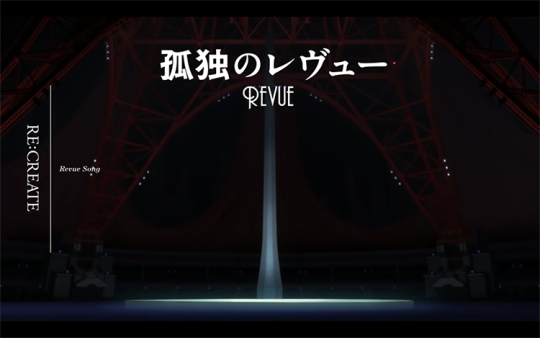
Right off the bat, there are two sounds I want to focus on: the violins and the piano(and/or xylophone?) keys.
(0:06)
The Piano/Xylophone Keys as Lullaby Music
They remind me of lullaby music because of the high pitch. The sound is reminiscent of times when everything was still pure and innocent, and not tainted by how harsh reality is. This sound comes and goes a couple of times, and is mostly in the background, being overpowered by the other instruments.
(I’d like to point out that I’m 100% sure the lullaby sounds are not just only piano keys. They might be xylophones at times or even chimes... or a triangle? Whatever they are—I’m calling them lullaby music.)
The lullaby music being in the background is representative of how Hikari is still warming up to the idea that she and Karen can be on the same stage together. These sounds are only completely audible when Hikari fully reflects about their promise, and begins believing in it. I’ll talk more about this later on.
(0:07)
The Violin(s) as Fairytales
This initial violin sound reminds me of fairytale music—yet another theme in relation to childhood. The violin(s) sound very “flowy”—as if you’re being surrounded by their magic.
We are all captivated with stories as kids, and for Hikari, that story was Starlight. She loved it so much that she showed it to Karen. And Karen loved it so much that she saw herself and Hikari in it; believing that they could perform the play. Kids love roleplaying characters from stories, and they took that seriously that Starlight inspired them to pursue theater.
Fairytale settings are also known for having an ideal world where anything is possible. And of course, as children, you believe that two people can indeed stand on the same stage. Until you grow up and realize that’s not how the system works after all.
(0:30) The synth(?) reminds me of an igniting fire—a huge symbol we’ll see later on.
(0:43)
This is for the promise we made
Hikari’s lines in the entire song are dedicated to Karen. Let that thought sit throughout this whole analysis.
(1:48) The synth sounds come back in full-force, as the stage is filled with fire.

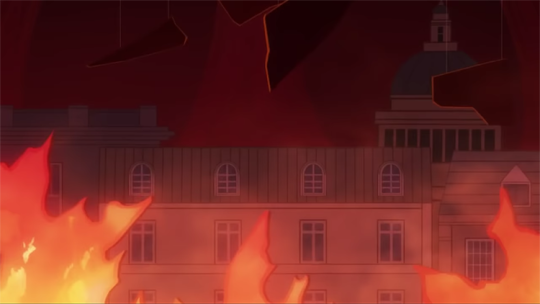

(1:57) Remember how I talked about that the lullaby sounds are just waiting to be heard, despite being in the background? This is one instance of it. In this part specifically, it sounds like it’s knocking on something. I would even say that’s indicative of how much the full memory between Hikari and Karen is just waiting to be explored.
(2:14) The lullaby-like keys are back, but they are in a more melancholic tone. They sound like they’re being defeated, and that is because Hikari’s stage is now filled with flames.

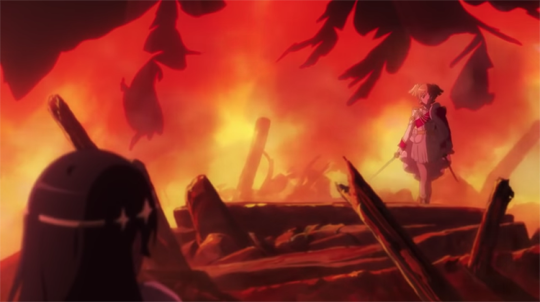

Fire as Passion, & Nana
Nana wants to keep the flame of the Seisho’s 99th class’ Starlight play alive with her reenactments.
Fire as Rage, & Nana
It is also a symbol of her rage towards Hikari, as her arrival broke the time loop. Hikari joining the auditions threw off Nana’s comfort zone. (Up until now, Nana thinks Hikari is the reason why things are changing—and not Karen—like we see her realize later on in EP9) And Nana has been trying so hard, in every iteration, to protect all their memories together. And with Hikari’s arrival, she has to deal with the possibility of leaving it all behind.
Fire as Destruction, & Nana
Aside from Hikari disrupting Nana’s loops, the fire shows how destructive her own wish is to herself. She tells the giraffe that her ideal stage has become too radiant for her to reach, but is still convinced she’ll get it someday. And that thought has trapped her in an endless spiral for who knows how long—preventing her to move on and progress further.
Fire as Destruction, & Hikari
Yes—fire is also a symbol of destruction for Hikari! It literally destroyed her stage!
The Fire and Grabbing Hand as the Top Star System
First of all, let’s make it clear that Hikari’s stage represents her time London.
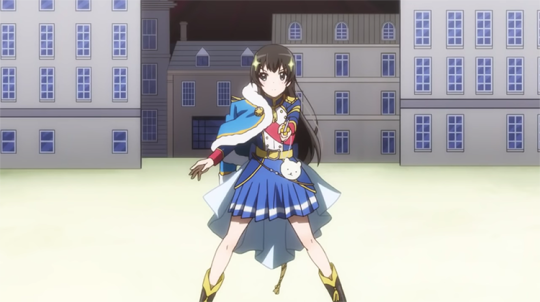
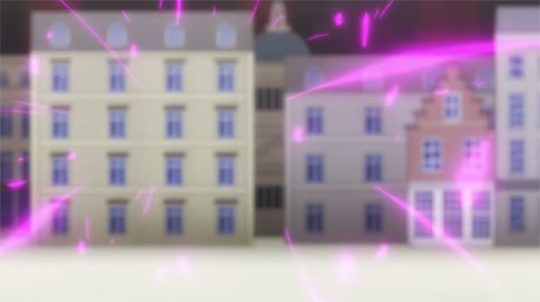
And more specifically, it’s the recital stage she performed on while she was at the Royal Academy for Theatrical Art.
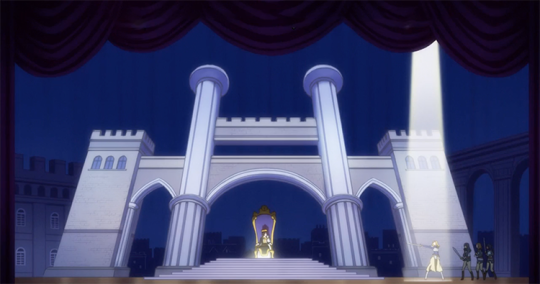
The very beginning of the Revue looked like this:

Hikari is standing on top of some steps, ready to challenge Nana. Her being on the higher plane indicates dominance and power, and she had that while she was still in London. She was so good that she got to perform in their auditions—until she lost. But before leaving, she was told, in the exact same setup during that recital, that “Someday, [she] will have to fight that thing”.


Which brings us back to where we are now:
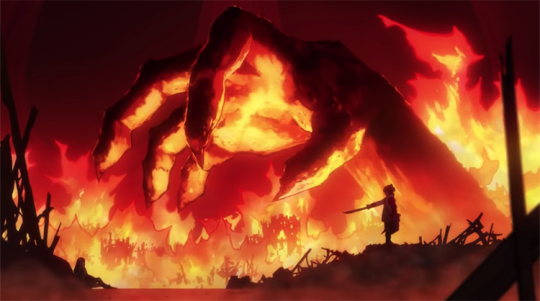
That “thing” could mean a lot of things, but one of my readings is that she has to face the reality of the Top Star system, and how destructive it is.
That system already destroyed her in London because she kept fighting in the auditions until she was just a pawn in their game. And when she was defeated, she lost all her motivation to become a stage girl. She realized how it feels like when the system makes a puppet out of you, and what happens if your brilliance as a star gets taken away. And that is all being mirrored by how wrecked her stage is right now.
The huge grabbing hand, along with the fire, emphasizes how powerful and controlling that system can be. We even get a sense of its massive scale in comparison their bodies. And see how it also has long, pointy fingernails? Remember in fairytales, how the villains always have those kinds of hands? Yup!
Nana is the one standing on a higher plane now, and the daunting hand is on her side of the stage, while Hikari is completely backed down to the ground. Nana clings onto destructive this system so much, that in this moment, her character represents it. Earlier in the Revue, Nana says, “You’re one of us now” to her. Hikari may have gone far in the London auditions, but she was back to square one in Seisho’s. Her weapon was even reduced from an actual sword to just a dagger.
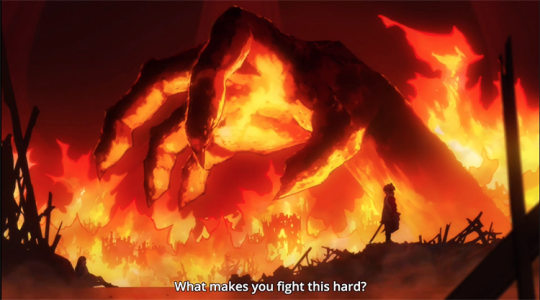
(2:28) Hikari is prompted in answering this question. And it seems very intimidating to tell this daunting stage that you and your friend made a promise to do Starlight together.


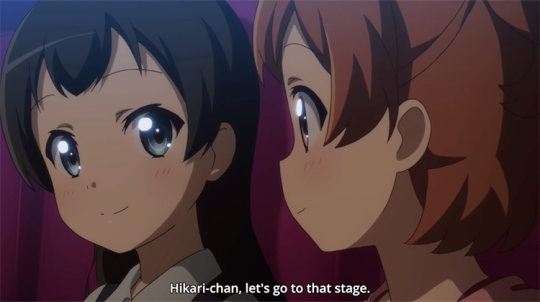

(2:40)
Lullaby Music as Comfort
But moments after, Hikari finally starts to face this fear. Once she begins to tell the whole story about how much Starlight means to her and Karen, the mood of the music changes. It’s more uplifting, and we even hear some hints of sparkling sounds as that memory brings her comfort. The music, along with the visuals, takes us to that happy place when there was nothing wrong in the world. In these few seconds, she is reliving that sweet fairytale in her head.

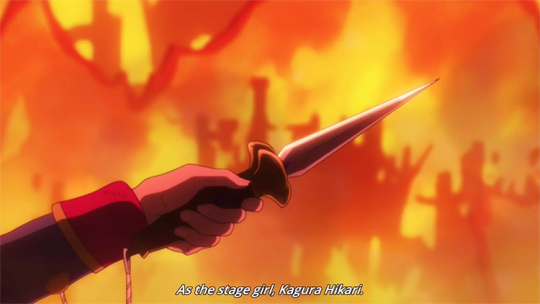
(3:05) The sparkle sounds are back again, right when she says, “That was the moment I was born. As the stage girl, Kagura Hikari.” And her hand isn’t even trembling anymore.
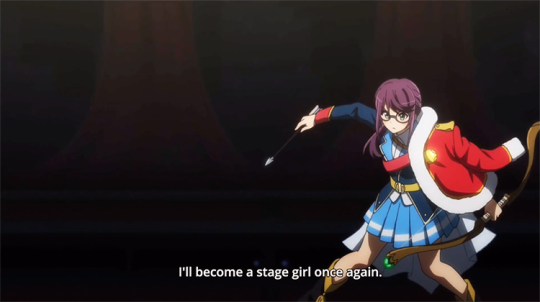

(3:24)
Intensified Violins as The Chase to Become a Stage Girl
Oh god, this is one of my favorite parts of the whole song. The music sounds like it’s chasing something. This “chasing” music, paired with the visuals of her very first Revue, shows that that was the moment she bounced back from her defeat. She started fighting again because she remembered why she wants to in the first place.
(3:52) it sounds like the music is being defeated again. This shift reflects Hikari realizing it is now inevitable that she would have to fight Karen in the auditions. We hear a loud bell too, as the visuals also took us back to reality, forcing us out of those dream-like flashbacks.

(3:59) I really love this because they are literally fighting on the last building standing. Hikari has that much foundation left, but it’s enough to keep her going. The scale composition is also good because you could really the tower, where the crown sits, as it looks down on Hikari’s burnt stage.
(4:16)
Lullaby Music Sounding Like a Child’s Wind-Up Music Box
Oh lord, another favorite part of mine. Notice how this is the only part of the song where the lullaby music is completely isolated. We are shown a flashback of that day where Hikari and Karen catch up on all those years apart from each other—the very day where Karen reminds her about their promised stage—at the same place they made it years ago.



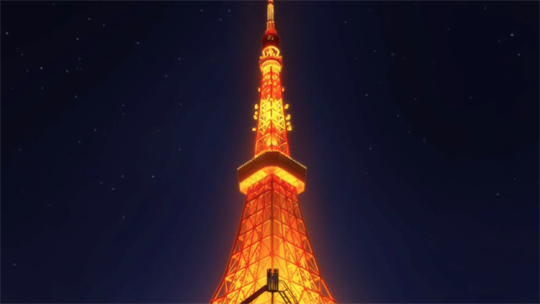
The lullaby music isn’t even a lullaby anymore—it’s a full-on children’s wind-up music box. And you know how you have to wind up its key all the way back, in order to hear the whole song? That’s exactly what happened on that day they caught up. They went back to the place they made their promise, as grown-ups. Karen reminded Hikari that if they can pass the auditions together, they could still stand on the same stage. And the very thought of that comforts Hikari so much, that she starts believing in it.

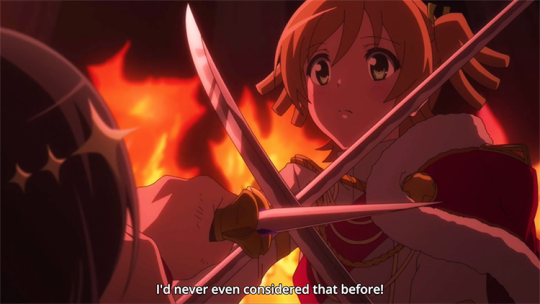

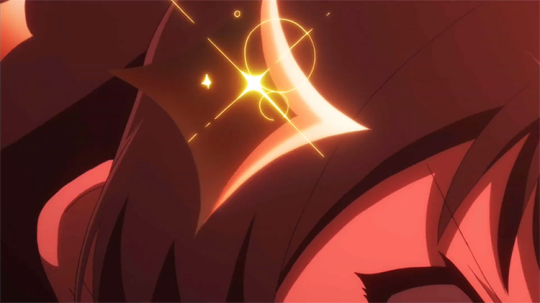
(4:39) Her hair pin—which Karen gave to her during the promised day—begins to shine, as she is empowered from all these memories.
(4:42) Alright guys here we go! The stage is shifting and so is Hikari’s weapon!. There is a lot happening, so let’s go over this one by one.
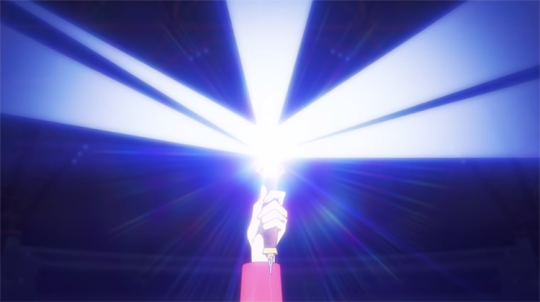

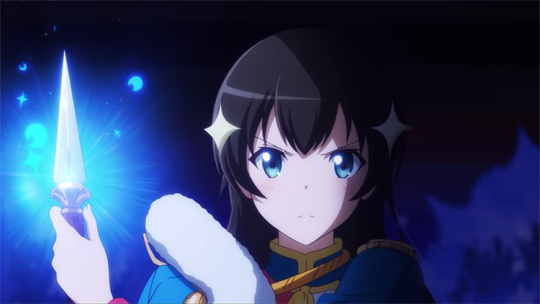
(4:51)
Hikari’s Weapon, Part 1: the Eye Motif
I like to think that the twinkling eye represents how much Karen has literally opened her eyes to the possibility of sharing the same stage together.
(4:57) The little “barriers”(/guard? quillion? Not sure what that part of a dagger is, and Googling can only go so far) weapon literally opens up too.

And having the lyric at this very moment be
Our dream unfolds
Is such impeccable timing.

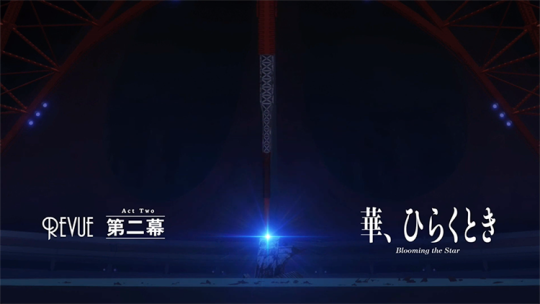

(5:01)
Tokyo Tower Falling
The Tokyo Tower falling into the water, causing a giant tidal wave, is how powerful Hikari’s promise is with Karen. All these memories she just reflected on elevated her emotions—represented by the water—so much that it’s overflowing.
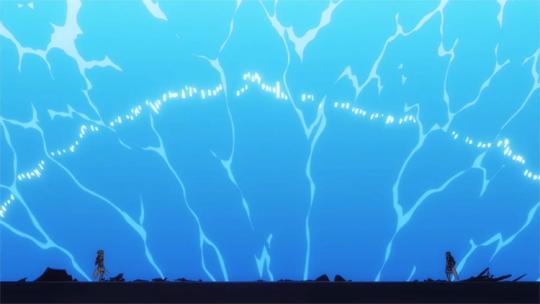

(5:18)
Literally—who could forget these magnificent succession of frames. Who. Tell Me.
Before I talk about the water, I’d like to point out that Hikari and Nana are finally standing on the same plane. Meaning they now both have the same amount of power to give their all in the audition.
Anyway, let’s discuss what all this water means.
Water as Emotions
As I’ve mentioned above, water is the element of emotions. The amount of water in this scene is how much emotion is contained and released within Hikari, as she remembers her drive to win.
Water as a Flowing Current and Tidal Wave
Water is an element that flows—free to literally roam around anywhere it wants to be. At times it can be blocked by huge rocks or pieces of wood, but a tiny stream will eventually form, and will find its way out. Water also comes and goes in waves, especially in the sea. These two qualities of water shows how Hikari is able to bounce back in times where she has lost. Despite how many times her flow has been disrupted, or her tidal wave crashed—she will always make a come back.
Water as Cleansing
Ultimately, the water is a metaphor for Hikari cleansing the toxic environment the burning stage had. Her memories with Karen are enough to get rid of it all—to wash off the destruction, and the doubt that they can’t win.
(5:25)
Water as Life
The lyrics here translated to English are along the lines of:
In the days when we were young
The small seed that we planted then
Has started to grow and bloom
Guided by the stars
The seed is Hikari and Karen’s promise to perform Starlight together. That seed is being watered every time they remember to wear their hair pins, even when they got enrolled in performing art schools, and as they became actresses in their school’s stage plays, etc. Their plant has been growing until it started blooming today—because of their reunion. And because of Hikari finally warming up to the concept that they can win together.
And you know, the Act 2 of the Revue is literally titled, “Blooming the Star.”
The music in this sequence sounds like actual happy fairytale music again—but there’s a lot more instruments this time, making it feel grander than before.
(5:40) There goes the “chasing” music again, adding even more drama to the emotional quality of the song. All of this shows Hikari’s fierce determination to win.



(5:45)
Hikari’s Weapon, Part 2: the “Hook” as Her Perseverance
No matter how far astray Hikari has gone during her auditions in London, she still managed to find her way back to her roots with Karen. Just like how the hook will continue to grip on the same spot, until one reaches that point after following the rope it’s attached to.
She also uses the dagger/hook as a swing, and you know how she literally swung back after being defeated? Yup.
Not to mention how great it is again that the lyrics are
I’ll reach my hand out towards you
is sung once she uses her newly transformed dagger/hook for the first time.


And with all of that perseverance, Hikari wins this round of the auditions.
The last thing I would like to point out are the last lines of the song:
Our bonds connected by the stars
Can make a miracle happen
Hikari finally defeated Nana—who has won the auditions countless times beforehand. Now I consider that a freaking miracle. But guess who else won?
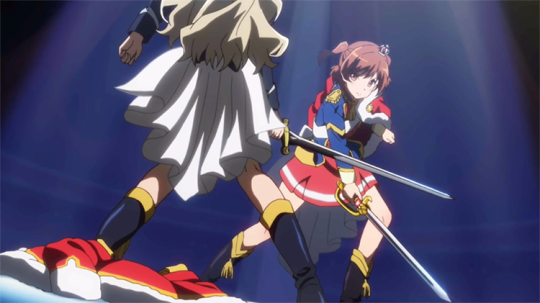
Karen. She won against Claudine too, the second-best one in the class. I would say that’s a miracle. Karen—the girl who jumped in—someone who wasn’t even supposed to be a part of the Revues in the first place. And she won because she holds her dream with Hikari so close to her heart.
And that ends this long analysis of Re: Create + the Revue of Solitude! If you made it this far, please know that I love you. And I hope all these small details will add to your experience in rewatching/listening to the song/scene again! Thank you for reading.
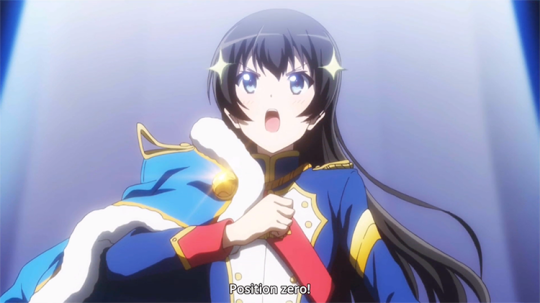
#hikari kagura#nana daiba#karen aijou#hikaren#revue starlight#shoujo kageki revue starlight#i can't believe i fucking did this#HIKARI IS NOT EVEN MY FAVORITE CHARACTER. FIRST OF ALL#i mean i love her but like#MIMORIN JUST DIDN'T HAVE TO GO SO HARD SINGING RE:CREATE OKAY#also if anything is grammatically wrong please spare me i haven't written a ~formal~ analysis in about 2 years#my analysis
49 notes
·
View notes
Text
Top 10 Switch Exclusives
With Nintendo finally pulling themselves out of the mild rut they found themselves in with the Wii U, the Switch is now producing games of monumental quality, so I’m here to take you through the top ten essential Switch exclusives for those of you who just don’t know which games to pick!
Note: I’m including Wii U ports here bc the Switch did them better and they’re still Nintendo so u know
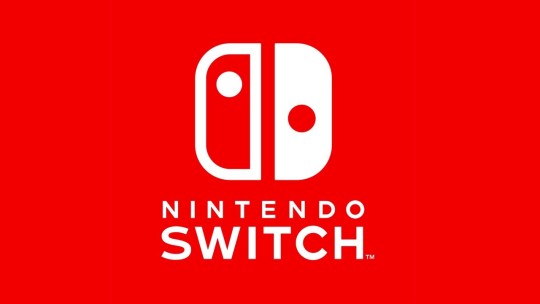
10. Octopath Traveler
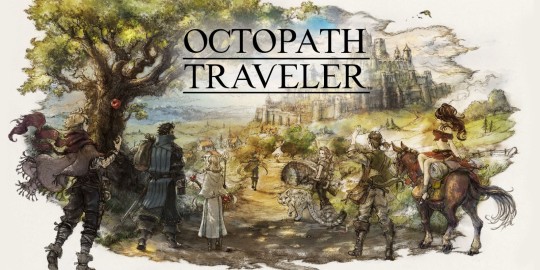
One of the many fruits of Nintendo and Square Enix’s growing partnership, Octopath Traveler is an adorable, retro-style JRPG that released on the system in mid-2018. The game features turn-based combat and eight playable characters that vary massively from each other in their personalities and backgrounds, meaning the game always has a fresh perspective. Overall, this is a creative but somewhat underrated title for the Switch that you should definitely pick up if you’re a fan of RPGs.
9. Donkey Kong Country: Tropical Freeze

The latest entry in the DK series brings all of the bright colours, charm and difficulty in glorious HD on the Switch. While this was ported over from the Wii U, it’s certainly a worthy port to say the least. For fans of challenging platforming, Donkey Kong will tick all the boxes for someone who enjoys fun, colourful gameplay that will sometimes make you want to tear your hair out in frustration. Though, if you want things to be slightly less hard, the brand new funky mode lets you play as Funky Kong (but to be honest with you, it’s still hard. I know I keep mentioning it’s hard but I just really need to drive that home).
8. Bayonetta 2

The critically acclaimed hack ‘n’ slash series Bayonetta, while it began on the Xbox 360, is now a Nintendo exclusive, and the sequel to the already mind-blowing first game is definitely something to behold. The fast-paced, combat heavy gameplay is perfect for the Switch and, of course, Bayonetta as a character is as brilliant as ever. So if you’re someone who would enjoy fighting massive demon creatures as a semi-naked, sassy witch then boy is the franchise for you.
7. Super Mario Party

It’s the game that everyone’s citing as ‘the one that made Mario Party good again’. That’s right, the latest iteration of Mario Party on the Switch has ditched the weird car system that made it not into a board game, and now it’s a board game again! Perfect for any small awkward friend group or big party you misjudged and brought a Switch to, this game comes packed with 80 new minigames. Which is a lot. So if you like Mario and party, then pick this up. Prepare for lots of motion controls.
6. Xenoblade Chronicles 2
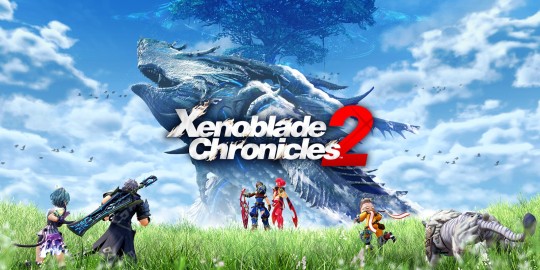
Another one for JRPG fans, it’s the latest entry in the series that made a name for itself for having anime-style protagonists with weird British accents, it’s Xenoblade 2! Another one of Nintendo’s charming, unique series, Xenoblade boasts an array of memorable characters, a polished, enjoyable combat system and a story just weird enough to be placed alongside most other JRPGs. Throw on top of that a solid DLC add-on in Torna and you’ve got yourself one fine viddy game experience that will definitely swallow up a couple hundred hours of your life.
5. Splatoon 2
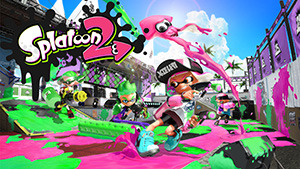
The Splatoon series is one of Nintendo’s newest, shiniest IPs that sees their first and hugely successful foray into an online shooter. Splatoon subverts everything we know about the online shooter genre, which now seems to be over-saturated with gritty, laggy messes with little depth and has given us a genuinely fun and colourful game. A variety of game modes, weapons and customisation options for your Inkling bolster this game’s addiction factor and, on top of that, the recent Octo expansion throws in a genuinely solid single player campaign to boot. This is one basically everyone needs to try.
4. Super Smash Bros. Ultimate

The latest and greatest in Nintendo’s flagship fighting series, Ultimate was basically dropped on us at E3 and gave us all a heart attack. If you somehow haven’t heard, Ultimate brought back every single veteran to the series, as well as a solid handful of new characters, plus DLC coming this year that includes Joker from Persona 5 and a plant. If that hasn’t piqued your interest, I don’t think anything will. One of the most ridiculously fun multiplayer experiences you will ever have is waiting for you in this game, especially when playing locally with friends, and the new spirits system has helped to conceive an equally amazing single player campaign, World of Light. This game is oozing with fun and intense love for the gaming industry and you can really tell how much hard work they put into this. Go play it.
3. Mario Kart 8 Deluxe

Quite possibly the definitive multiplayer experience, Mario Kart has been a staple of most people’s get-togethers since the first entry on the SNES. And much like Smash, Nintendo have created the series’ best entry in 8. Ported over from the Wii U, this game includes all of the DLC plus some new characters and karts, so for some reason you can now play as Link in Mario Kart! Cool! I don’t think anyone knows how to feel about this! The point is, it’s fun so you should probably play it.
2. Super Mario Odyssey

Odyssey is hotly contested to be one of the best 3D Mario games since 64, but even if that somehow isn’t true, you can’t deny how wonderfully unique it is. Each kingdom brings something new to the table; a lush, interesting environment in each one. With so many highlights to pick, from the brilliant puzzles to the new Cappy possession system to the boss fight with the massive dragon, Odyssey is packed full of content and collectibles to keep you coming back. Plus, the festival sequence in New Donk City? I want to play that bit forever.
Before I reveal the top pick that might seem glaringly obvious now, here are some other games that didn’t quite make the 10 but are also v much worth your attention!
Kirby: Star Allies
Pokemon Let’s Go Pikachu/Eevee
Captain Toad: Treasure Tracker
New Super Mario Bros. U Deluxe
Hyrule Warriors: Definitive Edition
1. The Legend of Zelda: Breath of the Wild

I mean, what else was it going to be? Zelda came roaring through the gates when the Switch was finally released and boy, did it deliver. Being the first Zelda game to delve properly into open world, an intense amount of love and detail was poured into every single moment of this beautiful game. Following the themes of lost memories and friendship, you travel across the vast land of Hyrule as Link trying to recover the memory of who he was 100 years ago. And each combat, each encounter, each visit to literally anywhere will leave you laughing, crying or anything in between. This was a game so powerful, it immediately became my favourite game of all time. I know there are a lot of people out there whose hearts are still with Ocarina, but for those new to the series who want a genuinely amazing, heartfelt experience, let Breath of the Wild swallow your whole life. As sinister as that sentence sounds, you really won’t regret it.
Thanks for reading! Let me know your favourite Switch game down below, if you wanna. Hope u find some money in one of your pockets that you didn’t know about.
#nintendo#nintendo switch#botw#zelda#the legend of zelda#legend of zelda#breath of the wild#mario#Super Mario#super smash bros#Super Mario Party#super smash switch#super smash ultimate#Smash Bros#smash bros ultimate#smash#splatoon#octopath spoilers#kirby star allies#kirby#xenoblade#bayonetta#donkey kong
7 notes
·
View notes
Text
June 25: How the Ultimate Trailer Works So Well
Amongst all the thoughts and discussion regarding Super Smash Bros. Ultimate, I don’t think any individual element of the game - even more than the confirmation of Ridley - warranted the level of adoration and excitement as not just the inclusion of every Smash character ever, but the short “Challenger Approaching” trailer explaining that.
So I decided I’d take some time and analyze it for how it works. Hoo boy, did that take longer than I expected.
youtube
For ease (and because I’m, well, lazy), I’ll be splitting this up into bullet points. I should also note that I’m avoiding a lot of stage analysis except in certain cases, largely because the emphasis on fighters is the focus. Also, this is quite long, so a “read more” tag is needed for this one.
Before the video: Sakurai adds this whole “character numbering” element, which is odd. Most viewers less familiar with this scheme (which has mostly always existed within the series) assumed this indicated the total number of characters from the start, but more than that it inherently acknowledges cut characters, something Sakurai tries to avoid as to not make their fans feel worse. No matter who is watching, it’s odd, and sets up the actual video in a way that feels odd.
00:02 - 00:15: We see Battlefield, something which since Brawl has always functioned as a focal point for the series - kind of in the way Mario does, too, which is why he appears here. Traditionally, Mario is also the character who reflects the visual direction of each game the most, so his “Brawl meets Smash For“ art style confirms it as a new game, one that will marry multiple iterations of Smash.
0015 - 00:28: Kirby, Samus, and Bowser are all Smash staples (two from the first game, one from Melee). They’re also not in numerical order, telling us to not expect things in a “normal” way. They also more clearly show a few returning stages, Castle Siege and Green Greens in particular, and Giga Bowser seems to function in a far new way.
00:28 - 00:34: Link is also one of the central Smash characters, but his drastic redesign tells us further that this will be a new iteration - one that will look to more recent games, at least in part (we also see a new Breath of the Wild stage, alongside Temple). Keep in mind that he gets a huge amount of time to emphasize this.
00:34 - 0:44: We see a lot of Donkey Kong (including a change to his Giant Punch), but it’s Falco’s appearance in 00:42 that’s surprising. He’s typically and understandably a hidden character; showing him off is kind of bizarre. For most viewers, it’ll just seem nice for a beloved character to return, but for the more attentive first-time viewers it is somewhat odd and continues the off-kilter vibe of Sakurai’s introduction.
00:44 - 00:48: Marth casually shows off the new changes to Shield Breaker, just like with DK earlier. Further indication that old fighters will have, to quote Sakurai from a decade ago, a “slightly different flavor this time around,” and that it won’t simply be an expanded port of Smash for Wii U (this emphasis will continue throughout the video and into Nintendo’s continued promotion of the game.
00:48 - 00:52: New Zelda! Not really new Sheik! Their having their default costumes implies they will remain separate fighters, and Zelda’s in particular bucks a trend of Zelda and Link’s costumes coming from the same game.
00:52 - 00:54: Our first post-Melee fighter, Villager, shows a new ability. His appearance also begins to move us from the more classic Smash fighters into a wider variety of ones new and old.
00:55 - 00:58: Meta Knight and Mewtwo. Notable for the former being the first Brawl character in general and the first one shown, and for the latter being the first Pokémon representative - before Pikachu, even. Mewtwo also looks like it did in Smash For, an indication the DLC would not be ignored.
00:59 - 01:01: And here comes Sonic - with a new version of Super Sonic and a returning Green Hill Zone in tow - as the biggest guest fighter out there, though that doesn’t confirm whether less established third party content would be joining him.
1:02 - 1:08: Peach and Pikachu, each with slight new changes in how Toad and Volt Tackle work. It’s notable how long it took to get to either of them, though their being more famous leads nicely into...
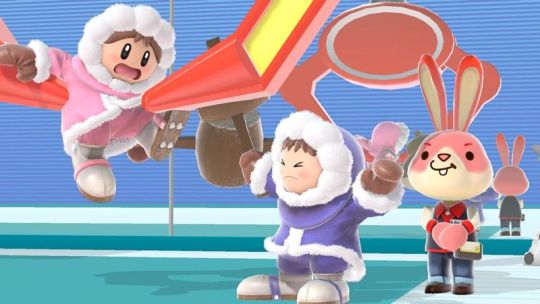
1:09 - 1:15: the Ice Climbers! Their return is such a big moment it’s hard to notice we’ve also got a returning Summit (and Living Room), and they unsurprisingly get a whopping six seconds to show off how they look in HD.
1:16 - 1:21: And from a beloved, long lost fighter to a highly desired new one, Nana and Popo formally introduce Inkling, with both a male and female design in tow. We get a good look at how diverse their weapon selection is, alongside a new Splatoon stage.
1:22 - 1:27: Pretty much the only thing we need to see with Falcon is the Punch, while Zero Suit Samus and Wii Fit Trainer show that even the less “iconic” of the cast aren’t going to be ignored. Given Boxing Ring’s centrality to Smash For, its being so prominent here makes sense.
1:28 - 1:30: here’s where things get weirder. The Ice Climbers coming back makes sense, but the Pokémon Trainer? I don’t really think it’s vague on whether the switching mechanic will return (he’s in the back, so...), but it’s out of the blue in a way none of what we’ve seen here is. That it only lasts about two seconds makes it all the more shocking.
1:31 - 1:36: Ness and Lucas. A little surprising for the former, given his traditionally being a hidden fighter, and more so for the former, who was last in the series as DLC.
1:36 - 1:41: The DLC concern becomes even more noticeable now, with Ryu fighting yet another normally hidden fighter: Ganondorf, surprisingly sporting the classic Ocarina of Time design Melee used. It implies a far greater amount of changes than what we were initially expecting, and assures the less confident of us that even third party DLC will not be ignored.
1:41 - 1:44: And look who else is looking new, but Ike, who’s reverted to the design Brawl used...except he isn’t. While the Inklings were expected to have male and female versions, this is the first indication we’ll have more pronounced alternate costumes for specific characters.
1:45 - 1:51: Cloud’s inclusion is another important one at this point, because compared to other guest fighters, the possibility of his return seemed far more up in the air. He gets a lot of airtime, space that comfortably confirms his two outfits and Omnislash, a great flashy move to send us into the big moment.
1:52 - 1:55: If Cloud’s return wasn’t a sure thing, than Snake’s was a pipe dream for fans (myself included). Having one go to the other is smart, because after him, Ice Climbers, and Pokémon Trainer, Snake‘s chances feel so much more possible. And it works so well. We don’t see an attack, or anything, because we don’t need to. It’s Snake, on Shadow Moses Island. That’s enough for us, until...

1:56 - 2:01: “EVERYONE IS HERE!” really just speaks for itself, but I’d also like to note the small feature of Snake running right after the words appear. It’s subtle, but it’s a flash of energy leading to the rest of the video (an energy that is supported by the music, which becomes far more intense up until the end). And it’s important to him be behind the words, because by this point a viewer is processing them, recognizing the totality of what that means.
2:02 - 2:04: And to prove how serious that claim is, Jigglypuff - the last of the original cast (minus Luigi and Yoshi) - brings back Pichu, likely the very fighter most people would think of after hearing that “everyone is here”: “even Pichu?” That the joke character of Melee has returned is proof of the claim, an example of how insane and wild this project is planning to be. But despite how notable it is, the two Pokémon are onscreen for only two seconds.
2:15 - 2:18: Truthfully, the next few reveals are less exciting. Roy is the fifth DLC character revealed to return, but Olimar, Diddy, and Lucario are all fairly normal. But it’s with Lucina that we get yet another oddity. She’s 21ε - an indication that something different was being done with the then-called “clone characters.” It’s yet another indicator that Smash is going to be different, and in rather unexpected ways.
2:26: It’s not a big detail, but Dr. Mario lacks the Epsilon, indicating that he’s different from how he used to be (given that he, Lucina, and Dark Pit are associated as the Echoes of the previous iteration of Smash, it stands to reason people might look for that on him, too).
2:30 - 2:32: And there’s Dark Pit literally one shot after Doc, with the Epsilon. It’s important to keep it all in mind more easily. I also think it’s notable that Palutena’s moveset isn’t shown at all in here; it’s one more thing about which Sakurai’s been coy.
2:39 - 2:42: It’s important, I think, to have the two versions of Link show up together; it highlights how they’ve both functioned as spinoffs of one of Nintendo’s (and Smash‘s) most important heroes. By this point, Young Link is the final character (again, other than Luigi and Yoshi) who came from a game before Brawl; he’s important as one more reminder of this game’s scope.

2:46 - 2:49: And if there were any fighters whose fate would seem as up in the air as any third party character, it’d be the Mii Fighters. And yet, they’re all here, too. And like with Palutena, we see no customization or anything beyond some very basic attacks.
2:55 - 2:56: Despite not being a huge surprise, Pac-Man’s new Final Smash (or new version of Super Pac-Man, technically) is fast, really fast. And that’s good because it kicks up the pace right to the finish. Like, it’s weirdly intense to watch at that point.
3:00 - 3:03: Wolf! While calls for him were probably not as loud as those for Snake and the Ice Climbers, he has remained a beloved Smash character and a fighter people really wanted. Having him here is good for a bunch of reasons - he was the last newcomer in Brawl, his style works really well for this point in the video - but probably the most is that people really wanted him back especially. And holding off on that until now helps emphasize this game’s scope.
3:04 - 2:08: Mega Man needed to be the final main shot for a lot of reasons. He’s a beloved gaming and Smash character, he’s got name recognition, and especially because his Final Smash is the best way to send off us. It’s just this huge blast that keeps up the momentum right until the end.
3:11: And we have the title. “Ultimate” really is perfect word for this, a video that is pretty much just about the history and power of Super Smash Bros.
3:16 - 3:20: ...But it also wouldn’t be Sakurai without some goofing around, so we let the air out of all this pomposity with some silliness from Luigi and Yoshi. I think it makes sense for more reason than Sakurai often using those two for mirth. The Brawl trailer had all this bombastic, dark energy...but then Wario showed up and farted. The first Smash For trailer seemed exciting and crazy...and then Wii Fit Trainer appeared; almost all the character trailers after it had stingers afterwards, mostly goofy ones. It’s a good and important statement that Smash will always be goofy and weird. And you got that in some individual shots (Dedede and Wario, for instance), but it’s a deliberate anticlimax that mocks you, but only slightly, for all the energy you’ve hopefully gotten from what is a very long trailer, all things considered.
So, what have we learned, aside from me realizing I need to come up with shorter topics for this blog? I think it’s that you could have made this announcement any way. Sakurai could’ve just shown the character selection screen, Nintendo could’ve put it out in a press release, or they could’ve just not mentioned it entirely (though that’d be insane given that “everyone is here!” is the game’s tagline). But a video was the best way to do it. And I think this way was the best video they could’ve realistically made. Every fighter gets to show off a ton of personality in a couple seconds, and by basing the whole video around being before or after Snake, it can position the ideal fighters in a way that lets viewers slowly realize how much grander this is going to be than they realized. It’s all just great design in general, and more than just a really cool trailer that showed things off.
(Link to my writings on Super Smash Bros. Ultimate)
3 notes
·
View notes
Text
1. Hong Hong & Alex Paik
Hong Hong and Alex Paik discuss paper, the exiled body, and resistance vs interdependence

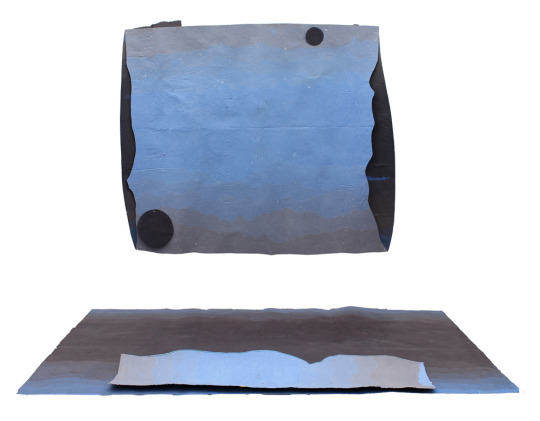
Hong Hong, Composition for an Emergent Brightness and Its Lesser Return, mulberry bark, dust, hair, pollen, fiber-reactive dyes, repurposed paper, water from Lake Erie, and foliage: Milkweed and Winged Sumac, 87 (H) x 90 (W) x 36 (D) inches, 2020
Alex Paik (AP):
One thing I am especially drawn to in your work is your commitment to paper, a material that we are both deeply interested in. Paper is its own living and breathing material that bears the scars and memories of anything it comes in contact with -- the leftover grooves and scratches from graphite, the slight buckling and warping from being exposed to water, or even fading as it is exposed to light. You talk about this quality as it relates to the body and the experience of diasporic and exiled bodies. Can you speak a little more about this relationship?
Hong Hong (HH):
The process of making paper relates to three different kinds of bodies.
The Biological Body: In papermaking, the body is a soft machine. Papermakers use their bodies to transform different materials into paper by intentionally exposing them to heat, weight, water, time, and gravity. Hand paper formation involves a specific sequence of steps, which are repeated each time paper is made. Like choreography, it is an act that vanishes. The surface of paper is the sedimentation of these movements and gestures. It gives form to the biological act of living. You speak of leftover grooves of graphite, and the slight buckling and warping from being exposed to water. There are also often lines where each sheet has been folded and unfolded. These qualities, over time, reveal how we touch the world and how the world touches us: existence is additive and reductive.
I also think about the horizontal and vertical axis a lot. We defy gravity to walk upright. We give into gravity during rest: our bodies are prone when we sleep. We can say the same of our bodies during the process of dying. The floor and wall components in recent work reference these two distinct states of being:
1) The horizontal (intuitive): where we acquiesce to physical circumstance and where we dream
2) The vertical (rational): where we attempt to assert our agency and make decisions
My Own Body: I was the first grandchild born to my grandparents. I was a girl, but they were not disappointed with me. My mama, apoor, gonggong, and I all lived together in the same apartment. This is not unusual in China. My grandmother used to make me stand against the wall, so she could mark my height once a week. It was always a joyous occasion.
My grandparents are no longer with me. I wonder nowadays: How can I perceive and understand my own changing boundaries without them? How does a single body locate itself in a room or in a landscape? So, I work outside daily, on a surface that measures a little less than 12 ft x 8 ft. These dimensions are the exact distances I can reach without losing control of my balance. The lengths have changed over time: I’ve lost about two to three inches in the last four years. They remind me of time and of life, as the effort it takes in order to cross both.
There is an intimacy to making paper: I think about my apoor measuring my height against the wall. This is not legible to others. But that’s okay.
The Exiled Body: There is an old Chinese myth about the beginning of the world. In a time before time, all that existed was an egg and a giant who slept inside of it. His name was Pangu. His repose was the universe. His stillness was the one and the all. His body was an origin and an end. One day, he wakes up. In darkness, he swings his axe to separate the sky from the earth. He slowly pushes the sky away from land. After thousands of years, he dies. His hair becomes forests and trees, his eyes are the sun and the moon, and his voice is thunder. I’m fascinated by notions of world-building and stories of how we came to be. I don’t think that this is surprising, given that I immigrated to the US when I was young.
Exile, for me, has always been about the irrevocable distance between myself and something else. Distance is blue. That’s why this color surfaces a lot in my work. Blue is also the sky,, which is everywhere, no matter where I am. The sky is a taciturn blue passing over everyone. There is something sad and comforting about its ubiquitous silence. Exile is also about the legibility of my body and experiences. Abstraction is anything that is mediated by symbols. The body begins as a collection of material, the same way that landscapes do. I think identity is both an experience and an image, read or seen by others.
I travel to faraway places to make paper. These journeys to make paper in different locations are attempts to reimagine my own experiences in border-crossing. In some ways, it is also tied to ideas of navigation and a continuous sense of movement from place to place. A lot of my recent work consists of four different sheets of paper tacked together to form a floor and ceiling work. They reference the cardinal directions. I work outside. All the work puts my body in spaces where I am estranged from myself and separated from my identity. This is somehow necessary. All work is the work of this body. All work is a search for this body. Therefore, all work is always the same work.
AP:
This is so beautiful. When you talk about the horizontal/vertical shift it makes me think of Yi Fu Tuan’s Space and Place, where he talks about babies going from prone to walking and how that relates to a baby’s sense of agency and place in the world. I certainly feel this conversation between agency and acquiescence happening in your work and your process, especially with how you are manipulating paper/letting paper be manipulated. You are working with paper not so much as a metaphor for the body but as a body, and the intimacy of seeing the record of your body in relation to the paper’s body comes through quite clearly: a marker of time, and a measure of your body as it shrinks over time.

Hong Hong, documentation of complete environmental pour, Vermont 2019
AP:
Was there ever a shift in your work when you went from using manufactured paper to making your own, or have you always made your own paper? What is important to you about the papermaking process?
HH:
I’ve never worked with manufactured paper the way that I do with handmade paper. Manufactured paper functioned, for me, as a substrate. I’ve always been interested in drawing and painting as processes of accumulation, where each action has the potential to become an abstract temporal measurement (like a breath or the swing of a pendulum). I also love materials that can hover between object and image. I like the flattening that happens in representation. I also love dealing with gravity. I don’t think these processes are separable or different: they are ultimately about the transformation of energy into form. I think I was able to make the jump between painting and papermaking because of these interests.
I learned how to make paper when I was in graduate school. I went for Painting (long story short: had to go to grad school because of visa issues). In graduate school, I felt alienated from the history of painting, as it was presented by a primarily white institution. Papermaking seemed to offer something different. It seemed to say that what I was learning about and exposed to, is not the only narrative. I also kind of loved that my painting professors hated it! I love that paper, before anything else, is an object. I loved that I had my own memories of burning holy paper at temples when I was young. I believe objects have the capacity to materialize complex beliefs into concrete things (value) that are tangible and exchangeable. They carry tacit values about specific moments in time. The conditions for the production, usage, and erosion of objects are both personal and collective.

Hong Hong, The Mountain Which Does Not Describe a Circle II, mulberry bark, sun, dust, hair, pollen, fiber-reactive dyes, repurposed paper, water, and foliage: Loblolly Pine and leaves from an unknown tree, 91 (H) x 128 (W) inches, 2021
AP:
This idea of something hovering between object and image is something I think about, too. My geometric units function both as images and as the material with which I build each installation. In terms of composition the temporary nature of each iteration of my pieces resists the idea of a static composition and links the image to the potential of the materials (the folded painted geometric units).. When I was making paintings I never felt comfortable making an image out of thin air -- I always needed some sort of resistance (like projecting old video game screenshots) as a way of having something to work against. The white of a canvas is very different from the white of paper (even if it is manufactured). To me the white of a canvas feels like starting from zero, while the white of the paper already has a sort of history and aliveness to it to respond to.
When I decided to move to only working with paper over ten years ago it felt like I had come home. I was especially drawn to the way paper softened the geometric forms I was working with. Looking back now I think it has to do with never feeling like I quite belonged in the (white) history of art and painting specifically and wanting to find a way to approach and relate to this history from another perspective. I still love and appreciate a lot of Western painting, but I don’t think I can ever go back to it. It’s so funny how people talk about paper as a “humble” material, only because it makes me think about how Euro-American painting is perhaps, by extension, the opposite lol. Our work is fragile and easily damaged. I am ok with my work having a finite lifespan, and I think about how presumptuous and egotistical it is to be a painter who wants their work to live on forever. To me the idea of paper being “humble” is more the product of wanting to privilege other materials and traditions than any sort of inherent humility in paper itself.
HH:
My partner, Jamey, is a painter. He’s reading a book called Almost Nothing. It’s a collection of writing about precarious practices. He told me a phrase yesterday that is really beautiful: “the syntax of weakness.” Openness to touch is the first condition of any object’s creation. Mark-making is only possible when a material chooses to absorb a gesture or a movement. In some way, it is about acceptance. A sheet of paper is the same as a boulder or the moon: they are changed by heat, pressure, impact, and time. Their malleability and porousness leads to material instability. In this way, all things engage with the act of writing their own histories. To live is to disappear: form records this disappearance.
Making paper is an arduous, physically demanding process. It depletes my resources each time it occurs. Something is born, as I die. For me, manual labor is a way for time to enter into my body. It returns me back to matter. This quality of impermanence is also in the body of the work. I, like you, was largely uninterested in the plasticity of paint. I also wasn’t necessarily interested in its immortality (I say this, and I love the work of so many painters). I didn’t know it at the time, but I wanted to work with something that is alive. This is also why I choose to work outdoors. You speak of resistance, and I feel that too, when I make paper. Limitations are wonderful. They tell me where I am.
I feel it when it rains on my work. I feel it when I go to new places and the object cannot come into being the same way it did in a previous location (do you sense this, when you create installations?).
AP:
I do! Each space has different lighting conditions and a different scale, which I unconsciously and consciously adapt to as I am onsite building the installation. Sometimes I literally have to work around/against awkwardly placed outlets and “architectural features.” At other times there are even time constraints -- if I am traveling or only have a certain amount of time to finish due to childcare/scheduling/etc.

Alex Paik, Partial Diamond (Slice), gouache, colored pencil, paper, nails, dimensions variable, 2019, installed at Praxis New York, 2019 (approx. 5.5 x 6.5 x 11 feet)
HH:
Everything changes due to season, humidity, weather, and millions of other factors that sort of seamlessly flow together to become landscape, and our tactile and sensorial understanding of it. For me, making paper separates experience into its distinct, constituent parts: sun, heat, collision, water, foliage, weather, gravity, etc. And the paper, once dry, stitches these segments together to form a whole. When I make paper, I feel something pushing back at or rising up against me. In a way, I’m fighting it. But I want to be accepted by it too. There is a simultaneous sense of absorption and alienation. In a recent interview with Artmaze, Bridget Mullen was talking about painting and they said that alienation teaches us empathy. Now I think of that when I work.
I love painting. I also love what you said about painting being the process of creating something out of thin air. I think of what I do as painting, if painting is a depository process and not a creative one. I think that life can be irrevocably difficult, but there are moments when the world is still and beautiful, like a drawing. That’s what I love most of all. A lot of my work is about erosion, alienation, exile, etc. But it is also about pleasure and happiness. I always wake up early in the day and start working at dawn, in the blue-dark. I feel the sun on my back and the coolness of the water between my hands. I feel the temperature rise. The wind shifts. Parts of me can disappear in those moments. Like painting, papermaking unfolds within quotidian time. Sometimes time can be unwavering in its perpetuity. But sometimes time becomes significant and bigger. It touches on the eternal and transforms into something unfathomable and long, like the sky. I am free here. I belong here. No one can take that away from me.
Can you speak more about resistance, as it relates to your work? There is a sense of vibrational geometry in your improvisations and installations: how is this related to the imagery you were working with in your paintings? Can you also tell me more about the temporary nature of the work? How do the compositions come into being (you speak of feeling)? Do they only come into being once and never again? Are parts disassembled and reassembled (reincarnation) to become other pieces? What perspectives did your decision to work with paper bring you?
I wrote a lot! It’s a nice day here.
AP:
I love it! So I’ll answer your questions in reverse order. My modular installations are made up of hundreds of the same geometric form, which are then hung up with nails temporarily on a wall when I have a show. Now that I think about it, in a way I am also making my own material like you are making paper. Each resulting composition is a unique iteration or performance of the same piece that will never be repeated in exactly the same way. In other words, the piece itself (a collection of individual units) has no static form or image but rather only has the potential to combine and recombine into almost endless combinations. I saw this great quote by Sanford Biggers recently that talks about how the basic logic of patchwork/quilt making is “to constantly be rebirthed in a new form, using the same materials.” And that is a very succinct way of describing what my work is about. And although these new relationships and forms are on the surface primarily concerned with shape and color, they become metaphors for speaking about other types of rebuilding - whether it is the way that a nation can reassemble itself with the same flawed individuals or how we as individuals can rebirth ourselves constantly using the same elements of our identities, either through code-switching depending on the social context or through sustained unlearning/relearning.
I think less about resistance in my work but more about interdependence. That resistance of paper as a living material can also be described as an interdependent relationship -- I can coax it into certain shapes by folding/gluing/painting but then the paper also responds by warping, sagging, etc. The installations themselves have an interdependent relationship with the walls and the lighting -- the forms need walls and lights to reflect their painted colors onto. What is most visible when looking at my work is actually not the material itself (the paper and folded forms) but rather the results of this interdependent relationship: the reflected, hazy color.
HH:
I love thinking about the work as “a collection of individual units that has no static form or image”, but rather as “potential”. It breaks down barriers between the inanimate and animal, object and art, as well as the past, present, and future. I also love thinking about resistance in the context of interdependence. This is a helpful framework with which we can not only consider and approach ourselves, but also larger systems: political, social, geographical, mythical, etc.
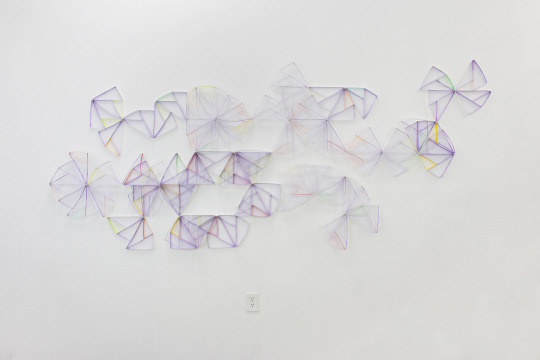
Alex Paik, Partial Equilateral Triangle (Two Right), gouache, colored pencil, paper, nails, dimensions variable, 2020, installed in studio, 2020 (approx. 4 x 8.5 feet)

Hong Hong is a visual artist whose practice spans craft, painting, and earthwork. Born in Hefei, China, she immigrated with her family to North Dakota in 1999 and earned her MFA from University of Georgia in 2014. Hong has exhibited at Crystal Bridges Museum of American Art, Georgia Museum of Art, Real Art Ways, Art League Houston, Penland School of Craft, and Jewett Arts Center. Her projects have been reviewed by Art21, Hyperallergic, Virtual Asian American Art Museum, Art New England, Southwest Contemporary, and Glasstire. Hong is the recipient of fellowships and grants from National Endowment for the Arts, MacDowell, Yaddo, Houston Center for Contemporary Craft, Connecticut Office of the Arts, and Foundation for Contemporary Arts.
www.honghong.studio
@honghongstudio
Alex Paik is an artist living and working in Los Angeles. His modular, paper-based wall installations explore perception, interdependence, and improvisation within structure while engaging with the complexities of social dynamics. He has exhibited in the U.S. and internationally, with notable solo projects at Praxis New York, Art on Paper 2016, and Gallery Joe. His work has also been featured in group exhibitions at BravinLee Projects, Lesley Heller Workspace, and MONO Practice, among others.
Paik is Founder and Director of Tiger Strikes Asteroid, a non-profit network of artist-run spaces and serves on the Advisory Board at Trestle Gallery, where he formerly worked as Gallery Director.
www.alexpaik.com
@alexpaik
0 notes
Text
Rises from absolutely nowhere, don’t mind me I’m just here to dump my feelings and opinions on Episode Ignis. Spoilers below obviously!!
One hell of an essay located under the cut, complete with somewhat separated sections and everything.
Gameplay: In the main game, Ignis has been the one who specialized in support – specifically offensive support, with the utilities he brought as well as his powerful link strikes. Regroup is such an amazing skill as well. So I was really surprised that, as a playable character, Ignis’ playstyle was more or less relentless assault. Of the three Episode DLCs I was the most aggressive as him – countering is far more rewardable than just dodging, and his mechanic revolves around using the right form of attack depending on the situation. I felt like it’s another way to show Ignis’ personality when he’s not just functioning as a member of their quartet, when he’s not merely guiding and giving advice to his friends. It’s a glimpse of the commanding presence he exuded when their quarreling in the mines became too much, and in it shows his steadfast resolve especially in this DLC’s premise.
Aside from that, I love how the fights and the mechanics gave me a flurry of emotions. There are the grandeur of the boss battles of course, as well as the determination brought out from the conditions of using the ring. A lot of these were visually pleasing! And yet, this very serious and very emotional DLC features party glasses that light up, the ability to cook while there’s missiles exploding all around you, and this ridiculous “friendly match” that involves vegetables, falling billboards, and oh my god Noctis Lucis Caelum don’t use the Ring of Lucii against your friends???
Level Design: Oh, Altissa. Part of me dreaded this setting because I got lost in its city quite a lot when I was there. But fortunately this version had more accessible areas and Ignis was being very Spider-Man so it was less tricky to explore! (I still did copious amounts of map checking though.)
I love how the mood of this area – and the mood of the DLC in general – is a stark contrast to Episode Prompto’s. Prompto’s DLC was quiet and isolated, one that encouraged introspection from one of our more energetic and louder companions. Meanwhile, Episode Ignis threw one of their more composed individuals into a high-tension and chaotic battleground, and this is why we see him at his most emotional state of mind.
Ignis: Oh my god. So, Ignis has been my favorite character since the very start and I always appreciated how he was on details, on how he wanted be sure of everything around him and be able to see it with a clear mind. I love that despite his stoic demeanor he is very warm towards his friends and provides them with undying loyalty. To be honest, if I was given a twist that being royal advisor to the king also meant they are their personal assassins I wouldn’t even bat an eyelash because I always felt like Ignis would have been the kind of person to kill somebody with no hesitation if it was for Noctis’ sake.
And in a way I was right, but also oh my god. When his name meant fire I was thinking of homey bonfires not this intense raging flame. This wasn’t out of character for me at all, this were things I knew Ignis was capable of doing, but nothing could have prepared me for the heat and passion that came alongside it. I have thoroughly underestimated what Ignis was capable of, and now I love him even more for it.
(To even think my first guess of the alternative ending was that Ignis was going to betray Noctis! I was such a fool! The absolute and complete opposite happened here!)
I’m a bit upset at Square Enix, they were using my weakness against me. A change in the eyes to represent power? Intense violin solos? Being angrily optimistic and wanting to punch destiny in the face??? I’m still in partial shock, to be honest. Ignis actually did That. Ignis Scientia actually did All of That. What a hero.
Verse 2, Meta: Is it a canon ending? In my opinion, it is because it’s made by the game developers themselves. Making Verse 2 canon doesn’t mean the main game’s end isn’t canon either! A lot of games have multiple endings and this one isn’t different. They’re both canon. What that does irk me though is how a lot of people seem to dismiss Verse 2 as just some way to pander to the fans because oh look, it’s a happy ending! But it’s an ending with so much substance in it despite its vagueness, and this is why it brought in so much theory and discussion. It’s an ending that, in its own way, made sense.
It doesn’t mean that Verse 2 is enough to replace the main game, however. There’s not a lot of details in here and I understand that – this is a DLC for Ignis, and so the content of this DLC rightfully focuses on Ignis. We don’t know how Noctis and Ravus and company did their journey towards Niflheim this time. We don’t know how long Ardyn had Ignis in captivity. There is no Episode Prompto, although I would wager that the chances of Prompto discovering his true identity and ending up in a similar experience are still fairly high – after all, there’s still this giant metal death worm to take care of. God, I wish we got to see either Noctis or Luna yell very very angrily at Bahamut for being such a massive jerkwad. It can’t replace the main game because you would need a fairly longer experience for that – and that is what I feel like they’re building up on.
Verse 2 is a teaser. The fact that this is a scenario that happened in the game means that it is a scenario that abides by the rules of this game world. After all, a possibility has to be possible. Which means – yeah, that’s right, there is a way to bring back the Dawn without following the prophecy. If they’re searching Royal Tombs then it means that a clue may lie within the history between the Astrals and the line of the Lucii. Verse 2 also hints at Ardyn’s background, especially since he’s going to get his own DLC soon. And they’re still making more content for FFXV anyway, what Verse 2 shows is a hint of what happened in this world, and if we may get our explanations soon.
Verse 2, Themes: I will be honest, I’m lukewarm towards Noctis’ fate of sacrificing himself. I accepted it eventually because in that point in the game, Noctis was already trapped and it was really the only way he could have saved everyone. They were never given a chance to try for an alternative, and there was little they could have done the moments the daemons wreaked havoc into the land. But at the same time, I was something I didn’t completely appreciate. It was because there was no time to truly understand the circumstances, no time to really work out the choices they have. Hell, even now we don’t have a full picture! It felt like Noctis was robbed of his agency to the point where the only thing he could do is to at least guarantee the safety and future for his friends. I am good with heroic sacrifices, but not like this.
(This doesn’t hold much weight into this, but it also didn’t help that XIV was also very fond of heroic sacrifices during the point XV got released. At least those characters had a choice and did it out of their own will, but it made me very tired of this trope regardless.)
I understand that sacrifice is one of FFXV’s themes, but so is friendship and the comrades that were made along the way. The way I saw it, the conclusion from the main game focused too much on the former, and Verse 2 was there to emphasize on the latter as a balance. Yes, sacrifice is sometimes necessary, but must it always be something that is paid in blood? Dying is easy, living is harder. There’s so many ways to explore FFXV yet, and restricting ourselves to the main game scenario feels like we our limited in our options to experience that. Verse 2 has its own things to offer, and those things they offer are something quite beautiful.
The first one is for Lunafreya – I believe it was by her will that she was able to communicate Ignis the details of the prophecy, and I do believe that she did so in hopes of finding a different future for Noctis. I think without Ardyn’s intervention she would tell Noctis this herself, but…well. Unfortunately, it was something Ignis was incapable of acting upon when he ended up blind, but in Verse 2 he was given this opportunity. Thus he was able to pass on this will to others as well.
Verse 2 can’t be any longer for the reasons I mentioned before, but I would kill to be able to explore the ten year gap in this iteration. This was a ten year gap with hope and determination rather than a growing dread and desperation. They were able to prepare, and that preparation was something so many individuals participated in. People from sidequests, allies from previous moments, leaders of other cities. These were all the comrades you made along the way, it showed that long journey you took, all the detours you made – those weren’t just extra EXP and gil, those weren’t just for nothing. It wasn’t just your own fight now, it was a fight for everybody that lived in this world, and everybody did what they could in order to face this upcoming apocalypse.
One thing I screamed a lot on during montage is where we see Ravus alive and well inside his home in Tenebrae. Tenebrae is intact. TENEBRAE IS INTACT! This speaks volumes – for one, Ravus surviving meant that Tenebrae can still function as its own country throughout these years. Secondly, it meant that there is a high chance that Niflheim wasn’t able to set it aflame as it was during the main game. We don’t know what happens to Niflheim and chances are it fell apart still in this timeline, but if it was able to find somebody to take command, it alongside the other countries might have been able to conduct peace terms – proper peace terms, this time – in order for everybody to become united against a common threat. There would be other concerns later on, for sure, but those can be resolved at a later time, once the Dawn greets them once more.
Nope, Noctis, no sleeping in the afterlife this time. You’ll have a lot of paper work to do.
(I just want more politics in FFXV okay)
I’m not sure if Verse 2 would ever be expanded more upon, or maybe I’m just a blabbering old fool and this really is nothing but fan service in the end, still I won’t call this other end as just something to please the fans. The themes this Verse presented are still the feelings and the emotions these characters would like to express, their desires and wishes and capabilities. And I hear them.
#* dragonspeak#final fantasy xv#episode ignis#ignis scientia#ffxv spoilers#oh god it's gonna take me a while to recover on all of this#so much happened
5 notes
·
View notes
Text
UT ramblings. undyne + monster politics
most people don’t seem to appreciate undyne the same way that they appreciate sans or pap etc. (I could go on for hours about how much the UT fanbase is far far faaar to focussed on sans but that’s not really relevant...) So i just wanted to bring up all the facts because most people don’t really realise that ALL the main characters of undertale are extremely 3 dimensional with backstory and depth and purpose and motivations and relationships and dreams. A lot of stories/art i see of undyne just focusses on her aggression, her over-enthusiasm or her relationship with Alphys, but she’s more than just some trope.
So i guess i’ll just start with the generic stuff and get more detailed as i go.
Hope for monsterkind
Undyne is a monster (gasp! never would’ve guessed that one would ya?) and so she is trapped underground with the rest of monster-kind underground. The sneaky thing about Undertale is it’s very good at giving us absolutely noooo reference points to infer the time of various events in it’s history (damn you Toby Fox for your sneakily vague ways) but the common conception i’ve encountered within the fanbase is that she was either born underground and as such has never seen the surface or that atleast she was really young when it happened.
Now this is important: to her getting out of the underground isn’t a lamenting about what has been lost, because she doesn’t have many/any memories to hold it towards, they’re all just stories to her. What drives her wanting to leave is little to nothing about leaving herself but providing hope for the monsters of the underground.
Backstory history stuff:
Monsters you can talk to from all corners of the game make it clear that they are actually struggling a great deal because of their situation with problems such as dreariness, overcrowding and lack of sunlight. They say that most make jokes and such to try and ignore the fact that there’s a lot to make them lose hope. Hope in leaving, hope in their situation in life improving, hope for there being any purpose to monster-kind existing at all.
A part of this despair is mostly from their royal dramas (namely Chara’s plan backfiring :P).
The loss of their royalty’s future heir, Asriel, to humans of all people after trying to make things right for them re-iterates just how much they are, even in this state, completely at their mercy. It emphasises how futile fighting it is - even if they do make it to the surface. Not to mention how knowing that their leader has lost his next-in-line would affect political confidence of the kingdom.
What makes matters worse is that Chara (yes. I’m using the true name to refer to the first human, it makes logical sense within lore to select the name most endorsed by the primary material. deal with it) was also a variable within the state of the people at this time. With the arrival of this human and the king and queens actions at making peace and welcoming them, Chara likely symbolised the first step in making peace with humanity - proof that monsters and humans could co-exist in harmony. With their death coupled with the involvement of humanity with Asriel’s actions to peacefully mourn them, it crushes all the ideals that came with that. Asgore, in response to the deaths, declared war on humans which would set the ground for monster-kind’s bias against them.
We all know how Toriel responds to Asgore’s actions. As people who play the game, the idea of her fleeing to the ruins and locking herself there makes perfect sense, but to everyone else at the time all they know is that their queen just disappeared one day. There might’ve been rumours about how she had been arguing with Asgore, how their marriage had begun to fail after losing their child, but the general public would just see it as their weakened royalty becoming even more so at their hour of need.
(ok... back to what i was actually talking about)
Anyway, Undyne is absolutely crucial to stopping them from losing hope. To put it simply, she inspires them. In a time when there are hundreds of reasons to hate life, and the only ones doing ok are either too ignorant to understand the problem or are simply pretending that they don’t exist, she is the figurehead for change. She takes action. Unlike their king who, for as a kind a person as he is, feels reluctant to take an assertive stance on the attack (opting instead to just sit around and wait for the humans to come to him, hoping they never will, like toriel put it) Undyne provides ways that monsters can be helpful NOW.
Many call her the hero of the Underground - and for good reason. Her passion is infectious, it inspires others and for the first time in a long time (again, don’t know how long though because TIMELINE). She makes them think it’s actually possible, like a future on the surface is within their reach. Afterall, Asgore already has 6 souls, all they need is one. She makes it sound so simple, so possible. It doesn’t hurt that she’s the most capable fighter the Underground’s seen in a while either (excluding Asgore obviously) which makes them feel powerful for once.
In short, Undyne is single handedly bringing momentum and hope back to the underground. Because of her the Underground at last is in a position to take back the surface and they feel empowered. And she’s not bearing it alone either, she’s bringing every lasts monster who wants to help with her, inspiring the masses to action.
What drives her (sorta linked to last one)
From a phone calls you can make in the echo flower rooms, we learn that she has heard the personal wishes of many monsters made to echo flowers all united in their desire to leave this place. I spoke a bit before about how it’s unlikely she has much experience with the surface herself. She’s doing this because she cares about others. What drives her is the dreams and determination of everyone she knows and cares about.
How awesome is that?! I mean, that concept alone should make her one of the most respected people in the game. Compared to Sans (and i’m not hating here, Sans is awesome too) who fights you because there’s absolutely no other options left, to let you pass would be to mean everything be deleted forever (i mean, how could you NOT fight at that point, he had nothing to lose); Undyne’s reasoning requires commitment, passion, energy, devotion! This isn’t something she had to do. This is the accumulation of all her compassion for the monsters and her bravery to stand for change. She’s doing this for the ones she loves, the ones she hates, EVERYONE. She’s doing this for her people, for Asgore, for the sake of monsterkind! NGGGAHHHHHH!!!! (sorry, got a bit carried away there)
Representing the people
Something that really resonates in the undertones of the game through her story arc is the responsibility she bears. She is the representative of the people, the hero, a role model to the younger ones and a saviour for the older ones. Everyone is following her because of her passion to the cause. She needs to be strong, to show just how committed she is.
Something that really shows in her character is how much she cares about the people who depend in her. She sees herself as someone who needs to meet that standard. Fortunately for her, she’s basically perfect for the job, being driven is who she is. She loves it, she loves the stakes, the fighting. The energy she brings to the table comes naturally for her, she’s a natural leader. Truly, she just bears the expectations of monsters like a real champ.
For an added bonus though, calling her in the room behind the waterfall shows she takes breaks too :) “When i feel like relaxing, i always take a break there. Which means NEVER!! I hate relaxing! I LOVE being ANGRY and STRESSED OUT! Just kidding.”
I like to think that Monster Kid kinda is an analogy for all the people she’s fighting for in the game. She’s his role model, his idol. He wants to be just like her when he grows up, even though he has no arms. The kid has no arms!!! And she still makes him feel like he can take on the world! Isn’t that just so inspiring? And what does she do when he gets in the way of fighting you? She takes him aside to protect him. She put the safety of a kid she barely knows before the epic fight she’s been dreaming of, the final showdown that will finish this once and for all. A lesser person would have just dismissed him and fought you anyway. But she’s not like that. Because she CARES. Extending the analogy even further, MK is an innocent, he just wants to be friends with you. And this confuses and annoys Undyne. Because everything she does is for them. Don’t they WANT her to break the barrier? That’s where a lot of her anger comes in about your ”goody two shoes schtick” in her fight.
Can i also point out that when you kill monsters in Snowdin, she remembers them? She lists them by name, defends their intentions and fights you to avenge them? How noble is that!
Determination!?
I’m still always flabbergasted that she actually USED determination. I mean, not even sans did that. Her cause meant so much to her, she had with her the support and hearts and dreams of so many people that it literally filled her with determination. For the sake of all monsters she refuses to even DIE! And when she starts to melt, her form physically incapable of handling the powers she’s meddling with, SHE STILL PRESSES ON. TO THE VERY LAST ATTACK SHE FIGHTS!
Just... just take a moment to think that through.
THERE’S MORE TO HER THAN BEING A HERO
I can see why people find her drive very two dimensional. Even with all the caring stuff behind it, which makes it more meaningful, she still comes off as very cliche protagonist. Firstly, she’s supposed to be like that, it’s ironic because she’s like a real life anime hero just like she idolises in Alphys’ um... *cough* history books. She’s sincere, it’s a fundamental character trait. She’s true to her convictions and when she wants something she takes action, some people are just like that. She has passion and she refuses to hold that back. Cooking with her definitely shows you that haha.
But she wasn’t always so popular. Can i remind people that, in true anime fashion, she ALSO has a tragic backstory that she refuses to let hold her back??? It’s actually mentioned a few times in the game but you never really notice it. Undyne is scary. Under any other circumstance, where she didn’t stand up to take the role and there was reason to admire her, everyone was too scared to be around her. That energy that everyone finds endearing made people frightened. She didn’t have many friends growing up because all the kids were to scared of the overly-aggressive fish monster. She says she doesn’t care about popular people to papyrus. It’s because, if things hadn’t turned out like they did, she too would be unpopular. She was alone, a misfit, strong and weird.
For me that really changes how i look at her. When she fights for the underground, she’s fighting for the people that used to be afraid of her. Her energy, the thing that left her ostracised, is the hope of everyone. I like to also reflect on how nice it is that she can fill this role too, it sounds just like a TV show for the strange one to rise up and be all that is good regardless. It’s also nice how she isn’t resentful of it. She still cares about the people as a whole and about each and every individual that makes it up.
Okay, now the alphys stuff
So i find the way that her and Alphys meet so enjoyable to look into. It’s heavily implied that Alphys has at times been suicidal (and there’s even suggestion to her taking this action in some of the neutral routes). Undyne meets her at the edge of a waterfall into the abyss and listens to talk to her for hours about the theories about what’s at the bottom. This is SO consistent with her character, of course she’d be the perfect kind of person to talk to when Alphys is like that. Undyne’s kindness shines through again. Also, the way that Alphys can go on for hours is just as driven as Undyne’s drive for other things. The parallels are what she admires about her.
It’s also cute the little things you notice that suggest she’s got a crush too. Normally Alphys’ side of the affection is what we notice but the tiny things... Like how a monster at Grillby’s knew undyne was off limits because she had a crush on someone. And how undyne would call alphys about the weather when there literally isn’t a sky. And how undyne corrected her statements about no nerds being allowed in her room. The water cooler being added in also shows that Undyne visited the lab often enough for Alphys to get concerned and install it - Undyne, a fish used to cold wet climates, literally went to a place filled with dry fiery rocks to see her.
Another thing i find fascinating about the pair is that they are quite similar actually. Both feel the need to bear responsibility in freeing monsters from the underground and face the pressure of wanting to meet people expectations. In a way, Alphys creating Mettaton has provided a similar effort to monster’s attitude as Undyne. Alphys researching determination is her way of fighting the barrier the same way Undyne leading the royal guard is. The difference obviously comes in the degree of confidence the two have, Alphys is clearly very insecure and her failure with the DT experiments only make it worse for her.
Papyrus
Sigh, do i even need to explain this one? She admired Pap’s dedication, respects him as a person and fighter and doesn’t let him join the royal guard because she worries about him which is really sweet. Instead of just flat out saying no, she even goes the extra mile of encouraging his other hobbies and entertaining his dreams. They’re good friends.
Random extras
She trained under Asgore and respects him a lot (but we already know all about that if from the cooking date). She was committed to fighting him again and again until she could finally beat him and pacifist Frisk reminds her of him. Sweet.
She plays piano. Can i point out that her fight is one of the few with straight up piano in the soundtrack? It’s a cool little easter egg and i can’t help but imagine her practising her battle music. It also ties in with the ancient artefact puzzle, which Undyne funnily enough made (a nice little extra :) )
#i don't know when to stop#undertale#undyne#deserves more respect#I basically just wrote and essay#I'm such a big fan it's not funny anymore#undertale trash
1 note
·
View note
Text
the 20 must-have Switch games you can play right now • Eurogamer.net
The Nintendo Switch is a sort of inverted version of the Wii or Wii U. While those consoles all but demanded that games had to be redesigned to make the most of their strange features, the Switch manages to make old ideas new again simply by allowing you to take them out into the wild. Dark Souls on the tube! Mario at the beach!
While Nintendo’s had a thing for portability since the days of the Game Boy, the Switch is also defined by its multiplayer accessibility, and was sold on the unlikely promise of friends gathered together in public spaces crowded around a single screen. In the end, that sales pitch came true. So whether you’re looking for a game for the TV, the commute, or one of those improbably stylish rooftop parties from the launch ads, hopefully there’s something for you here in our list of the best Nintendo Switch games.
Editors Note: Eurogamer is relaunching its series of ‘best games’ features, starting with the Nintendo Switch. You’ll see more platform lists appearing on the home page in the coming weeks, with the aim to update them several times a year as new releases supplant a given system’s existing library.
The Legend of Zelda: Breath of the Wild
To make a game about nature, Zelda’s creators had to change the way they created. The precision tooling of every part of the environment had to be hidden, with intricate dungeons that clip together across the landscape replaced with massive vistas that at first appear thrillingly empty.
Do not be fooled. Breath of the Wild is as obsessively designed and crafted as any Zelda game before it, but everything in this huge, seemingly untamable game is put in place to make you feel lost and small and at the mercy of the elements. Pick a direction and explore: an adventure of genuine beauty and revelation awaits.
Want to read more? See our full Zelda: Breath of the Wild review and buy now from Amazon.
Super Mario Odyssey
Odyssey is a wonderfully, purposefully incoherent Mario game in which each world has its own costumes and gimmicks, but also its own defining aesthetic. After the rolling majesty of Breath of the Wild’s Hyrule, it’s a bit like diving into a jumble sale. But like all jumble sales there are brilliant things to discover: strange worlds that glitter with unusual textures and seem to be driven by alien rules.
And at the heart of it all, that brilliant sense of weight and momentum and pace that makes Mario the platformer than nobody else can touch. So Odyssey is a game of moments, in other words – and what could be more like Mario than that?
Want to read more? See our full Super Mario Odyssey review and buy now from Amazon.
Mario Kart 8 Deluxe
Countless others have taken on the Mario Kart formula since its inception in 1992, not least of which is Nintendo itself, delivering various mutations, variations and iterations over the years. It wasn’t until Mario Kart 8, however, that it matched the brilliance of the SNES original, with a work of stunning imagination and impeccable craft.
It wasn’t until the release of Mario Kart 8 Deluxe a few years after, however, that Nintendo delivered what’s inarguably the best in the series to date; bundling together all of the DLC that came to the Wii U version post-release, most importantly it also added a brilliant Battle Mode that completed the package. It’s thrillingly close to perfection.
Want to read more? See our full Mario Kart 8 Deluxe review and buy now from Amazon.
Splatoon 2
Splatoon 2 is a glorious team-based shooter with a unique territory capturing mechanic, but that’s only half of the appeal. The arenas are great and the weapons are a pleasure to use, and there is a simple playgroup joy to chucking that much ink around, but Splatoon’s Switch instalment lingers in the mind because of its placefulness.
Much has been written about the Switch’s bare-bones front-end. For the first days of the console’s lifespan, Inkopolis Square felt like it was the heart not just of this wonderful game but of the charming, personable, colourful and surprising console that runs it. What a thing!
Want to read more? See our full Splatoon 2 review and buy now from Amazon.
Super Smash Bros Ultimate
It doesn’t even matter if you like fighting games or not: Smash Bros is for anyone who’s ever fallen for video games full stop, a mad, impossibly expansive and expertly engineered celebration not just of Nintendo’s rich past but that of the entire medium.
The cast is outrageously vast, taking in all-comers from Mario to Metal Gear, the options are plentiful and the soundtrack is just to die for. Oh, and the game underneath all that is alright too, a wilfully chaotic dust-up that’s best enjoyed shoulder to shoulder with friends. You’ll find a little of all video games here in Smash Bros. Ultimate, a breathless celebration of the medium in all its mad, incoherent and joyous whole.
Want to read more? See our full Super Smash Bros Ultimate review and buy now from Amazon.
Arms
How’s this for a pitch: the Mario Kart team does for fighting games what it once did for driving games in a ludicrously colourful, energetic and original Switch exclusive. Yet despite delivering so well on that promise, Arms has never found the audience it deserves. For shame, though that shouldn’t stop you picking up what remains one of the highlights of the Switch’s line-up.
Here’s a fighter that’s instantly accessible, offers boundless depth and does all this with one hell of a spring in its step. Oh, and springs in its arms too, as your fighters reach into the screen in an enjoyably pliable brand of pugilism. The chances of a sequel now seem slim, so make the most of a game that’s truly one of a kind.
Want to read more? See our full Arms review and buy now from Amazon.
Tetris 99
Battle Royale Tetris sounds like a joke, but it turns out to be the basis for one of the most energising console exclusives in years. It’s Tetris, a game you’ve been playing forever, but now you’re up against an entire gameshow board of rivals.
There’s two kinds of beauty here: the beauty of a game you know innately being twisted into a new form, and then the buried beauty of the hidden rules and synergies that will see you racing up the leaderboard. Tetris isn’t just the eternal game, it’s an eternally surprising one.
Want to read more? See why we think Tetris 99 might be the best battle royale yet and buy now from Amazon.
The Legend of Zelda: Link’s Awakening (2019)
Link’s strangest adventure has long been marooned on the original GameBoy, with only a timely port to the 3DS reminding us of the weird island where the Wind Fish sleeps. For Switch the whole thing has been reimagined as a tactile children’s animation, but the puzzles and overworld are as precision-tooled as ever. This is a slight Zelda as they go, but it’s still rich in adventure and heart.
Want to read more? See our full The Legend of Zelda: Link’s Awakening Switch review and buy now from Amazon.
Cadence of Hyrule
It still feels wrong for anyone other than Nintendo to handle a Zelda game, but the highest praise you can give Cadence of Hyrule is that it doesn’t feel wrong for very much time. This is a beautiful reimagining of the flip-screen Zeldas of the 8- and 16-bit generations, shot through with a rhythm-action conceit so beautifully executed it feels like it’s always been a part of Hyrule. Unmissable.
Want more? See our full Cadence of Hyrule review and buy now from Amazon.
Picross S
Picross has become such an embedded part of Nintendo’s handheld portfolio that it’s easy to forget it’s there. It’s easy, in fact, to think these aren’t video games at all – they’re close relatives to sudoku, living alongside them in some publications as nonograms, and they offer the simple thrill of logic and deduction.
For all that, it’s easy to forget just how good the formula is, and see that you’ve clocked up *checks play time* 150 hours across the three instalments released to date on the Nintendo Switch. If it’s a commute-eating puzzler you’re after, they really don’t come much better than this.
Lumines Remastered
Lumines started life on the PSP, and despite the transition from Sony to Nintendo, Remastered feels like a homecoming. The only puzzler to truly challenge Tetris in terms of universality or brilliance – okay, maybe Drop7 comes close – is built for a screen like this, bright and luxuriously wide and yet held, somehow, in your hands. The levels have never looked better and the use of vibration is sublime.
Mostly, though, it’s Lumines back where it belongs, inches from your eyeballs, the timeline racing through again and again and leaving the glinting landscape behind it transformed once again. Jeepers this is good!
Want to read more? See our full Lumines Remastered review.
Windjammers
Once upon a time, there was nothing more exotic, nothing more nineties than the Neo Geo, and one game on that most exquisite and powerful of machines was more exotic and nineties than them all. From the chromed lettering of developer Data East to the wraparound mirrored sunglasses of Hiromi Mita, Windjammers is arcade perfection, serving up a delicious alchemy of Street Fighter and Pong.
It’s one of the very best local multiplayer games available, which makes it an absolute essential for the Switch. Now it’s not a case of hoping the pub you’re heading off to has a well-stocked Neo Geo cabinet propping up the corner – thanks to the marvels of modern technology, you can challenge someone to a game of Windjammers wherever you may be.
Want to read more? See our full Windjammers review.
Puyo Puyo Tetris
The blending of two puzzling greats, one austere and angular, one squishy and sugary, makes for an absolute classic in its own right. But there’s more to Puyo Puyo Tetris than the ingenious nature of its design.
In the early days of the Switch, this game above all others delivered on the console’s dream: a bunch of friends, loose in the world, all crowded round a tiny screen propped up on the table in front of them while four-player chaos unfolded. If you’ve ever wondered what that stand on the back of the Switch is really for, wonder no longer. It’s for Puyo Puyo Tetris.
Want to read more? See our full Puyo Puyo Tetris review and buy now from Amazon.
Darius Cozmic Collection
The Switch isn’t short of shmups. Pick up Konami’s Anniversary Arcade Collection and you can play Gradius 2, one of the greatest of them all, or maybe you want to sample the classic Thunder Force 4 via M2’s impressive Sega Ages port. Or you could go through a large chunk of Psikyo’s back catalogue, or get an impeccable introduction to the genre with the smart, accessible Danmaku Unlimited 3.
Or, if it’s just one game you’re after, you could turn to Devil Engine – an all-new effort that’s studied the classics and added its own unique flavour. It’s an incredibly enjoyable game, and one that looks – and sounds – the part too. Devil Engine just goes to show that, sometimes, they really do make them like they used to.
Want to read more? See our full Darius Cozmic Collection review.
Into the Breach
A tactics game concerned with the world’s dinkiest invasion, Into the Breach is a study in economy. From the game’s tiny play areas and short match times to the sparse animation and simple rules that govern a unit, everything here is bright and glinting and wonderfully fit for purpose.
Such basic elements lead to rich surprises, however, and this is one of those games that you can play for days and weeks and months without ever feeling that you’ve ceased to learn.
Here’s a tip to start you off: don’t just think about what a unit can accomplish on a turn, but also think about where it ends up once the turn is finished. If you’ve never played this, I envy you. Tactical perfection awaits.
Want to read more? See our full Into the Breach review and buy now from Amazon.
Animal Crossing: New Horizons
Nintendo’s legendary take on bucolic living has never been more sharply arranged than here, where a trip to an untouched island quickly expands to involve town infrastructure meetings and the search for the perfect bed-side table. Min-max this and it’s a game filled with depth and secrets. Play it for a lazy hour every day and it’s slow gaming at its most comforting. An unusual and distinct world-beater.
Want to read more? See our full Animal Crossing: New Horizons review and buy now from Amazon.
Fire Emblem: Three Houses
And there was us thinking Awakening was Fire Emblem’s big push for the mainstream… With Three Houses, Intelligent Systems handed the reins over to Koei Tecmo, for the most part, who then delivered an absolute epic of a strategy RPG. Its scale is at once personal and vast, its characters winningly human and the best bit, for older players of the series, is that the strategy is as satisfying as it’s ever been. An absolute triumph.
Want to read more? See our full Fire Emblem: Three Houses review and buy now from Amazon.
Astral Chain
Is this Platinum’s most loveable game? It’s a pocket-sized masterpiece, anyway, offering skipping-rope combat and a police procedural-world in which you hunt for clues but also put away litter and help out a mascot dog bag at the station. Effortlessly quirky and filled with delights, this is an action game with endless charm, and it feels perfect on Nintendo’s oddball console.
Want to read more? See our full Astral Chain review and buy now from Amazon.
Overcooked 2
The first Overcooked is just as essential a pick here, really, because the core premise is just the same: chaos with friends. The Switch is only half a console without its brilliant take on portable multiplayer, and Overcooked 2 is probably the best example of it. A game about food assembly under pressure where each player’s role is essential to your chances, it’s a classic of party-gaming comedy full of intense frustration, intense reward, and often a mighty good laugh. It’s also family friendly, if you can manage to bite your tongue.
Want to read more? See our full Overcooked 2 review and buy now from Amazon.
Ring Fit Adventure
Nintendo turns exercise into an RPG and creates a game that can be merrily binged while you slowly tone yourself up. Beautiful peripherals and a wonderful fantasy setting are backed up with lovely, witty writing and a thoughtful spin on home work-outs. Just remember to stock up on smoothies.
Want to read more? See our full Ring Fit Adventure review and buy now from Amazon.
If you want to hear us explain why we’re doing ‘best games’ lists, and how we’ve settled on the games we have, then you can listen to our process live with a dedicated episode of the Eurogamer Podcast. Do note that this was recorded at the time of our original, 15-game-long list, so a handful of these have changed (our apologies, Donky Kong).
Give our podcast a listen through iTunes, Spotify, RSS, and SoundCloud.
from EnterGamingXP https://entergamingxp.com/2020/04/the-20-must-have-switch-games-you-can-play-right-now-%e2%80%a2-eurogamer-net/?utm_source=rss&utm_medium=rss&utm_campaign=the-20-must-have-switch-games-you-can-play-right-now-%25e2%2580%25a2-eurogamer-net
0 notes
Link
Well, LeBron James did it again. There really isn’t much more to say than that. After Cleveland squandered a double-digit fourth-quarter lead, and LeBron himself turned it over with the game tied and less than 30 seconds to play, the greatest player any of us have ever seen (please, just stop trying to refute this) came up with a saving block on one end before, three seconds later, hitting the winning shot on the other to give the Cavs a 98-95 victory against the Pacers in Game 5.
First, the block:
Now, before we go any further, this was not a clean block. It was a goaltend, clear as day. Victor Oladipo’s shot hit the backboard before LeBron pinned it against the glass again. LeBron said as much after the game:
LeBron: “I definitely thought it was a goaltend. Of course.”
— Brian Windhorst (@WindhorstESPN) April 26, 2018
That said, the 3-pointer still would have won it, and here it is:
I’m sure that isn’t the first time you have seen those clips by now, and I’m even more sure this won’t be the first time you’ve read or heard some iteration of what I’m about to say, because sometimes there is only one thing to say: LeBron is brilliant in a way that few people have ever been brilliant at anything they’ve ever done in the world, sports or otherwise, but at what point will even he not be enough to carry this otherwise average-to-below-average Cavs team to playoff victories?
No way they can win a title. But can they get out the East? Given how flawed this Cleveland team is, it’s nuts that we can’t rule that out because of the greatness of one player. But this is important: LeBron by himself has not been enough before. Yes, his teams have been to seven consecutive NBA Finals, but he has also had far and away the best team — though not always by record — in the conference each of those years.
This season has echoed James’ first stint with the Cavaliers in some ways, particularly with the imminent free-agency decision lingering over proceedings. But rather than 2010, go back to 2009, when the Cavs lost to the Magic in the conference finals. James also hit a buzzer beater in that series. In fact, it was from pretty much the exact same spot on the court.
[embedded content]
LeBron’s winner on Wednesday vs. Indiana feels a lot like this shot he hit back in 2009 — a great play from a great player that feels futile in the grander championship picture, because ultimately the team is just not good enough. Delaying the inevitable, if you will.
The point is: Only one time in LeBron’s career has he taken a team that wasn’t the most collectively talented team in the conference to the Finals, and that was in 2007, when the Cavs, who gave substantial minutes to the likes of Larry Hughes and Boobie Gibson, got swept by San Antonio. In 2015, Kevin Love sat for most of the postseason, and Kyrie Irving was heavily limited, but the East was so weak that James’ Cavaliers didn’t struggle.
In other words, it’s an exaggeration to say LeBron carries teams through the East every year. He typically has help, certainly more than he does this time around. On Wednesday, LeBron posted 44 points, 10 rebounds and eight assists. For the series, he’s averaging a playoff-leading 34.8 points, 11.4 boards and 8.0 assists on 55 percent shooting.
That we have all just sort of come to expect these numbers says a lot about how amazing LeBron has been to this point.
That it is taking these kinds of numbers for the Cavs to take a skin-of-their-teeth 3-2 series lead against the fifth-seeded Pacers says even more about how amazing he’ll have to be moving forward.
The simple truth is that there is no other option for these Cavs. Either LeBron goes crazy, or they go home. This series is obviously there for the taking, but 59-win Toronto — which took a 3-2 lead on the Wizards on Wednesday — potentially awaits in the second round, and the Raptors aren’t the Pacers. Let’s say somehow they get through that series, the 76ers likely await, and good luck with that squad right now.
And yet, can anyone say with any kind of certainty these Cavs won’t end up making it to a fourth consecutive Finals? Do you really see LeBron just stopping with these kinds of performances? The guy can simply do whatever he wants, whenever he wants, or so it seems. It’s merely one of the reasons these playoffs have already been fascinating and stand to be even more so moving forward.
We don’t have any idea what’s going to happen, particularly in the East. What we do know is that whatever happens, LeBron James will have a lot to say about it.
Let’s block ads! (Why?)
Source link
The post 2018 NBA Playoffs: LeBron James saved the Cavs again, so how much longer will this work? appeared first on trend views word.
0 notes
Text
Serving of Tea #4: The last stretch

Excerpt from Devilman Crybaby, courtesy of reddit user Tomaiua.
Hello everyone!
I know it's been forever, apologies for this utter lack of updates.
I am not dead yet, and I have been working on Sylvan Disappearance all the while.
It has been pretty challenging, though.
It's also not over yet.
I've had a pretty busy semester school-wise with a certain research project, and working on both a visual novel and my research consistently has been……… pretty difficult.
I think I fared well enough, overall? Well, I still have some amount of work ahead of me.
At the same time, part of why this whole VN development thing took so long is because I didn't want to cut too much on sleep, social time, down time. For the most part, I have succeeded in this regard! Yeah for healthy habits!
Besides, I can announce that the scripting process of Sylvan Disappearance is now complete! This is the last stretch, finally.
Here is a brief description of what remains to be done:
Going through a last editing pass
I still haven't read the VN from back to back myself, and I absolutely need to do so!
For the sake of editing the text itself to a satisfying level of course, but also to ensure the internal coherence of the story and to polish the general presentation.
I ended up changing a number of core scenes during scripting, and if I do not ensure that the whole narrative is consistent, some parts might feel somewhat strange in the final result.
I might also cut down on the length of certain scenes! The story currently sits at a little over 45 000 words, which is actually quite a lot. I promised myself that I would not hesitate in cutting down where possible, if appropriate. We'll see.
Soo, yeah, the whole thing definitely goes a bit further than a mere editing pass.
Some amount of external testing
It's tempting to skip this step, but I know I shouldn't!
In the field of game developement, it's usually recommended to test early and frequently. This generally holds true for parser- or choice-based interactive fiction.
I am not sure of the applicability of this idea to visual novels, though.
Since they tend to be longer, and more linear —in short, more alike to regular novels— iterative testing doesn't seem as helpful. It usually doesn't make much sense to have someone read an incomplete draft, unless the projected length is very high, or specific feedback on a precise aspect is needed.
(I'd be curious to hear the thoughts of other writers on the matter!)
At any rate, I'll be kindly asking a few friends for help regarding playtesting, I hope it will work out!
Correctly attributing every free-to-use asset in the story
This one is going to take more time than it appears.
As I explained in the past, I rely extensively on photographic backgrounds with permissive licenses for the story, and it will probably remains so for the foreseeable future. As you can imagine, this practice of reuse extends beyond backgrounds: all sound effects and music in the story are somehow free to use.
Whether or not they use a Creative Commons license (which explicitly requires attribution), the authors of all these resources ask to be credited for their work, as they rightly should be.
I always strive to be precise and exhaustive when attributing specific assets! It's basically the least I can do, and it's even very little in comparison with the real, hard work which went into the production of original music, sounds, photographs.
However, explicit and correct attribution is not that common. It might be because in the mind of creators and final users alike, there's something shameful or cheap in the act of relying in pre-existing work, which all ties into our expectations of high production values regarding digital works.
This is of course very understandable, because commercial pressure requires market value. And there is obviously tremendous value in original art.
However, I genuinely believe that assets in the public domain or with permissive reuse licenses should be valued as sources of common wealth too. And this starts with rightly attributing these assets to the creators who kindly offered them to everyone.
The Creative Commons non-profit offers us both a succint summary of good attribution and an in-depth look at the best practices for attribution. I highly recommend checking out the latter if you're interested in the topic!
The baseline is that good attribution does take a little time, but not too much. Ideally, the title, the author, the license and a link to the source should be included.
There are no hard rules though, it is more of an general ethical recommendation.
As stated in the page: “there is no one right way; just make sure your attribution is reasonable and suited to the medium you're working with. That being said, you still have to include attribution requirements somehow, even if it's just a link to an About page that has that info.”
The best practices page also acknowledges that attribution is harder in non-textual media, like games and videos, and suggests different methods of attribution.
I've personally settled with:
A succint summary of all the contributors on the itch.io page that will host the VN. It merely lists names by category.
This summary is also reported in the rolling credits at the end of the game.
An in-depth credits menu inside the game, accessible from the main menu at any time. Each track, sound and background is visible either with a thumbnail, or with an audio player. In all cases, the credits menu explicitly lists the author, the license, background information on the asset and a link to the source.
I won't lie, coding a credits menu takes a little time!
I still think it's worth it, and I hope some players enjoy having a look at the assets that went into making the whole VN, and learn a few things about the numerous real-life locations and talents behind it all!
The credits menu itself is mostly coded now, though I still have to add the audio player for sounds and music, and to fill it with all the assets.
I've also coded the rolling credits at the very end, and I similarly only need to fill them with the names of all the involved authors.
Attributing each asset with all the required information will take some time, though. It's relatively easy to get lost in the task, to spend hours tracking the source of each asset if it was not cleanly compiled somewhere prior to beginning. I learnt this lesson the hard way in the past.
For Sylvan Disappearance, I prepared myself correctly. I've been using a giant spreadsheet to keep track of each and every asset used in the course of the story, with all the required information easily accessible by column.
I even added bookmarked assets that I did not intend to use at first, for easier reference in case they became useful.
Here's a sneak peek:
Now all I have to do is reporting each and every line in the credits menu. It will take time, but it is doable!
A potential release date?
When will this VN finally come out? ...I... still can not say for sure.
This month, this much is certain! I am almost done with schoolwork, but I will most likely be busy again in the second half of April anyway. But overall, Sylvan Disappearance should be released by April 26 at the latest!
(Most likely, it will be released right before April 26.)
That is all for today! This should be the very last long-form serving of tea before the release.
I will endeavour to write very short promotional posts. And since I still cannot show anything else from the game itself, I will find something else. I already have a small idea, I think it can prove interesting!
Until then, take care everyone!
0 notes
Text
Penn Is History’s Best 16 Seed. Can It Pull Off The NCAA Tournament’s Greatest Upset?
There are only a few things left in sports that have never happened: five homers in a game, a sub-two-hour marathon, a quintuple double. Probably the most famous, though, is the knocking off of a No. 1 seed by a No. 16 seed in the men’s NCAA Tournament. (A 16 vs. 1 upset has happened once on the women’s side, when Harvard beat Stanford in 1998.) It’s actually kind of weird that it hasn’t happened yet; although No. 16 seeds are usually pretty bad, you’d think at least one would have broken through over the course of 33 years and 132 tries. The 133rd No. 16 to take a crack at it will be the Ivy Leaguers from the University of Pennsylvania, which faces Kansas on Thursday — and Penn’s chances of beating a No. 1 are among the best a No. 16 seed has ever had.
For starters, Penn is a lot better than the usual No. 16 seed. According to our Elo ratings — which measure a team’s strength based on (among other factors) who it’s beaten and by how much — the Quakers rank 76th in the country, with an even 1700 rating. How good is that? By definition, the typical D-I team rates around 1500, and since they first became a thing in 1985 (excluding this season), No. 16 seeds have had an average Elo rating of 1483.1 Before Penn this year, the highest-rated No. 16 seed of all time was Portland State, which carried a 1698 rating heading into the 2008 tournament. (It ended up losing, to Kansas of all teams, by 24.) Penn is officially the first No. 16 seed ever to break the 1700 barrier in Elo:
Penn is the best No. 16 seed ever (according to Elo)
Highest Elo rating for No. 16 seeds going into the NCAA Tournament, 1985-2018
Year Team Conf. Elo tournament loss 2018 Pennsylvania Ivy 1700 — 2008 Portland State Big Sky 1698 61-85 vs. Kansas 2015 Manhattan MAAC 1643 64-74 vs. Hampton* 1985 Southern SWAC 1636 59-83 vs. St John’s (NY) 2012 Lamar Southland 1635 59-71 vs. Vermont* 2012 Vermont AEC 1629 58-77 vs. North Carolina 2006 Oral Roberts MidCont 1629 78-94 vs. Memphis 2017 S. Dakota State Summit 1621 46-66 vs. Gonzaga 2012 UNC-Asheville Big South 1619 65-72 vs. Syracuse 2010 Vermont AEC 1619 56-79 vs. Syracuse
* Play-in game
Source: Sports-Reference.com
It’s also worth noting that Ivy League schools are usually not relegated to being first-round cannon fodder. According to the NCAA, the Ivy’s 43 all-time NCAA Tournament wins makes it the most successful conference outside of the six major conferences and the top mid-majors.2 Ivy teams have won three of their last five games in the round of 64 (and that doesn’t even include Cornell’s Sweet 16 bid in 2010). And the two first-round losses were by a combined 4 points. Some of that is a function of seeding, but that’s also the point. The last time an Ivy League team was seeded as low as 16th was 1989, when (coincidentally enough) Pete Carril’s Princeton squad came the closest to knocking off a No. 1 seed of any 16-seed ever, losing by only 1 point to Georgetown:
youtube
Of course, even if Penn is the best No. 16 seed ever, the Quakers aren’t playing another No. 16 seed on Thursday; they’re playing Kansas, which just earned its 14th No. 1 seed in program history. KU has wiped the floor with No. 16 seeds by an average margin of 25 points per game, with only one (Western Kentucky in 2013) keeping the final score within single digits.
One piece of good news for Penn, however, is that this year’s Jayhawks aren’t quite as strong as they’ve tended to be in their other top-seeded seasons. With an Elo of 1985, Kansas is well below the historical average (2071) for No. 1 seeds in the 64-team-bracket era. Only nine other No. 1 seeds have had a lower pre-tournament Elo in that span than KU has this season.
So Penn-Kansas might be the perfect storm we obsessive 16-over-1 hopefuls have been waiting for: a combination of the best No. 16 seed in history and one of the weaker No. 1 seeds. According to Elo, the 285-point gap between the Quakers and Jayhawks is the smallest for any 1-vs-16 game in tournament history.
Is this the 16-vs-1 matchup we’ve been waiting for?
Smallest differentials in pregame Elo ratings for No. 16 seeds against No. 1′s in the NCAA Tournament, 1985-2018
No. 16 seed No. 1 SEED Year Team Elo Team Elo Elo Diff. 2018 Pennsylvania 1700 Kansas 1985 -285 2006 Oral Roberts 1629 Memphis 1931 -302 1985 Southern 1636 St John’s (NY) 1948 -312 2010 Vermont 1619 Syracuse 1986 -366 1990 Arkansas-Little Rock 1607 UNLV 1990 -382 2008 Portland State 1698 Kansas 2102 -404 2017 South Dakota State 1621 Gonzaga 2029 -408 2013 James Madison 1574 Indiana 1986 -412 2011 UNC-Asheville 1594 Pittsburgh 2008 -415 1985 North Carolina A&T 1544 Oklahoma 1963 -420
Source: Sports-Reference.com
There is one big catch, however. The game will be played in Wichita, Kansas, just two-and-a-half hours down the road from the Jayhawks’ campus in Lawrence. Because our full-blown tournament model — which contains many accuracy-boosting bells and whistles that pure Elo differential ignores — takes travel distance into account, it gives Penn only a 5 percent shot at the historic victory. That’s still really high by 16-seed standards — the best chance since the current iteration of our model rolled out in 2013 — but comparing that to the typical No. 16’s win probability is like saying the Cleveland Browns had a better winning percentage in 2016 than in 2017. Sure, it’s true, but neither number is especially good.
In other words, the Quakers probably won’t win. Unlike practically every other 16-vs-1 matchup, though, this one should give you a millisecond of doubt when filling out your bracket. We always say that, eventually, a No. 16 seed will beat a No. 1 seed. For Penn, there might be no time like the present.
from News About Sports https://fivethirtyeight.com/features/penn-is-historys-best-16-seed-can-it-pull-off-the-ncaa-tournaments-greatest-upset/
0 notes
Text
Why Are Miners Involved in Bitcoin Code Changes Anyway?
This is a Trial Version of Social Share & Locker Pro plugin. Please add your purchase code into Licence section to enable the Full Social Share & Locker Pro Version.
Developers, startups, miners … all have played a role in bitcoin’s technical debates. But if you’ve been following, you may have noticed the attention being paid to whether miners are “signaling” for various proposals.
Before we dive into what that means, it helps to understand that the term “miners” actually relates to a diverse group of people.
First, all miners develop, build or deploy the specialized computers designed to compete (or help others compete) for network rewards, and in the process, help move bitcoins from person to person. The role may sound mundane, but there are concerns that miners have, or may one day have, too much power over network decision-making.
Since some argue that it was originally envisioned that every bitcoin user would help secure the network – as opposed to massive companies – miners have long been the subject of the less-than-trusting imaginations of the network’s users and security-conscious developers.
With just about 20 mining pools out there, some controlling large chunks of the underlying computer power, there are long-held fears that they could potentially conspire to attack the network and, as a result, reduce confidence in bitcoin as a secure and stable online currency.
Complicating matters is that, over time, miners have also developed a secondary role: helping bitcoin add new technical features. And, similarly, users have grown to worry that this position could be abused.
Indeed, you could argue that the group contributed to recent uncertainty about bitcoin’s future. With several competing proposals on the table, there were many different ways this summer’s code changes could have unfolded, and miners were integral to each.
At points, it even felt like their approval of the change was the sole thing keeping bitcoin from splitting into two competing blockchains. (It’s worth noting that some miners might even end up doing just that).
This game was on full display last week when mining pools began signaling support for an upgrade earlier than expected. One mining pool began embedding information in blocks indicating it would follow through on an action, then a flood of others joined. It wasn’t long before all miners were on board.
Users cheered on social media while keeping track of the blocks left to upgrade by refreshing tracker pages – at least, until the page stopped loading due to overwhelming traffic.
It was a relief. It looked like a split had been all but avoided following a long period of uncertainty.
Explaining upgrades
Like all software, bitcoin needs to make upgrades to fix problems or to add new features. However, in bitcoin’s case, the entire distributed network needs to stay in sync.
One way to upgrade the software is what’s known as a “soft fork,” one way to change the rules that keep all the nodes in the network in agreement.
Soft forks are backwards-compatible changes that don’t require all nodes to upgrade. As such, users can “opt-in” to the new rules. Node versions from years ago can be used to send money to upgraded nodes, even though they don’t follow these new rules.
Now, nodes might not need to upgrade, but at least some mining pools do.
Think of it this way: Mining pools are the ones who mine new blocks of transactions, so they need to accept and follow the new rules in order that the new types of blocks and transactions can actually be added to the blockchain.
Supporting the change
Here, there are a couple of points to keep in mind:
For the soft fork to avoid splitting bitcoin into two assets, at least 51 percent of bitcoin’s mining hashrate needs to support the change. Otherwise it will be the “shortest” chain with less computing power and its blocks will be rejected by the rest of the mining pools.
It’s hard to know how many mining pools have upgraded to support the change, since it’s not information.
The more miners that support the soft fork, the better. This diminishes the likelihood of certain attacksand network disruption as mining pools shift to the new rules.
In some cases, such as the code change P2SH, this shift to the new soft fork rules occurred via a “flag day,” also known as a “user-activated soft fork” (UASF).
A UASF works like this: Developers, nodes and businesses, set a “day” (actually a block number) that’s, say, six months or a year into the future. At that time, upgraded nodes will enforce the new rules and reject blocks that don’t support them.
In theory, mining pools will generally opt to upgrade for fear of losing the block rewards that come with enforcing the rules and adding blocks (worth about $33,000 today).
However, this process hasn’t been trouble-free. Some miners haven’t been properly prepared in the past, and have lost block rewards in the process.
Because of this, developers developed a system that requires 95 percent of bitcoin’s miners to “signal” that they are prepared for the change. (The second iteration of this idea, which allows for multiple soft forks to be deployed at once, is Bitcoin Improvement Proposal (BIP) 9.)
That’s why bitcoin mining pools have signaled for soft fork upgrades for the past several years.
Clash of code
A few recent competing scaling proposals have involved mining pools.
Most take the form of what’s called a Bitcoin Improvement Proposal (BIP), and there are many that have been in a state of flux of late. Some even rely on each other in order to bring about changes.
BIP 141, created by developers for users and miners seeks to introduce Segregated Witness (SegWit), uses BIP 9. BIP 141’s rules require 95 percent of mining pools to signal support for SegWit before activating the change.
But, unlike older changes, most mining pools didn’t signal support for BIP 141. It stalled at 30 percent of miner support for a while. Some mining pools indicated they did so to negotiate for a 2MB block size parameter increase. Others suggested that some mining pools had an incentive to “block” the change to make more money.
(Interestingly, this “veto power” is a possibility that some developers raised much earlier.)
Some in the community were not happy that SegWit stalled, believing that BIP 141 would improve bitcoin and that mining pools were overstepping their job description. So, in the hopes of pushing SegWit through, many users and developers rallied around the older “flag day” concept, since it doesn’t require the “approval” of mining pools.
The proposal, BIP 148, is slated for August 1. A majority of mining pools would need to support the change, for the reasons described above.
BIP 91 was ultimately perceived as a sort of compromise between those two changes, one that kept miners in the driver’s seat.
The BIP 9 dilemma
While BIP 9 is a recently-introduced mechanism for making upgrades to bitcoin, some developers already want to get rid of it.
Some claim it was intended as a way of protecting miners – so they wouldn’t lose their block rewards if a soft fork went through and their blocks were rejected by the rest of miners.
Like some users, some developers don’t like that mining pools used the signaling mechanism as a way to stop code changes that otherwise had broad agreement from bitcoin users.
Blockstream developer Rusty Russell, a former Linux kernel developer and one of the creators of BIP 9, went as far as to publicly apologize for his role in creating this possibility.
“I hadn’t expected that this checkpoint would be used as a chokepoint to ransom the network,” he added before advocating for a UASF.
Future outlook
Given this controversy, what role will miners play in upgrading bitcoin down the road?
It’s unclear. BIP 9 had wide support from developers before it prompted political disagreements.
Some developers still seem to favor so-called “miner-activated soft forks” as a less disruptive option, but now some developers, such as Russell, seem more inclined to advocate for UASFs.
So, perhaps both options will be on the table for future upgrades.
Whatever the case, miners are important players who will continue to have some influence in future bitcoin code changes.
Disclosure: CoinDesk is a subsidiary of Digital Currency Group, which acted as organizer for the SegWit2x proposal and has an ownership stake in Blockstream.
Bitcoins on computer chips image via Shutterstock
Source: Coindesk
Related
Source link
Source: http://bitcoinswiz.com/why-are-miners-involved-in-bitcoin-code-changes-anyway/
0 notes